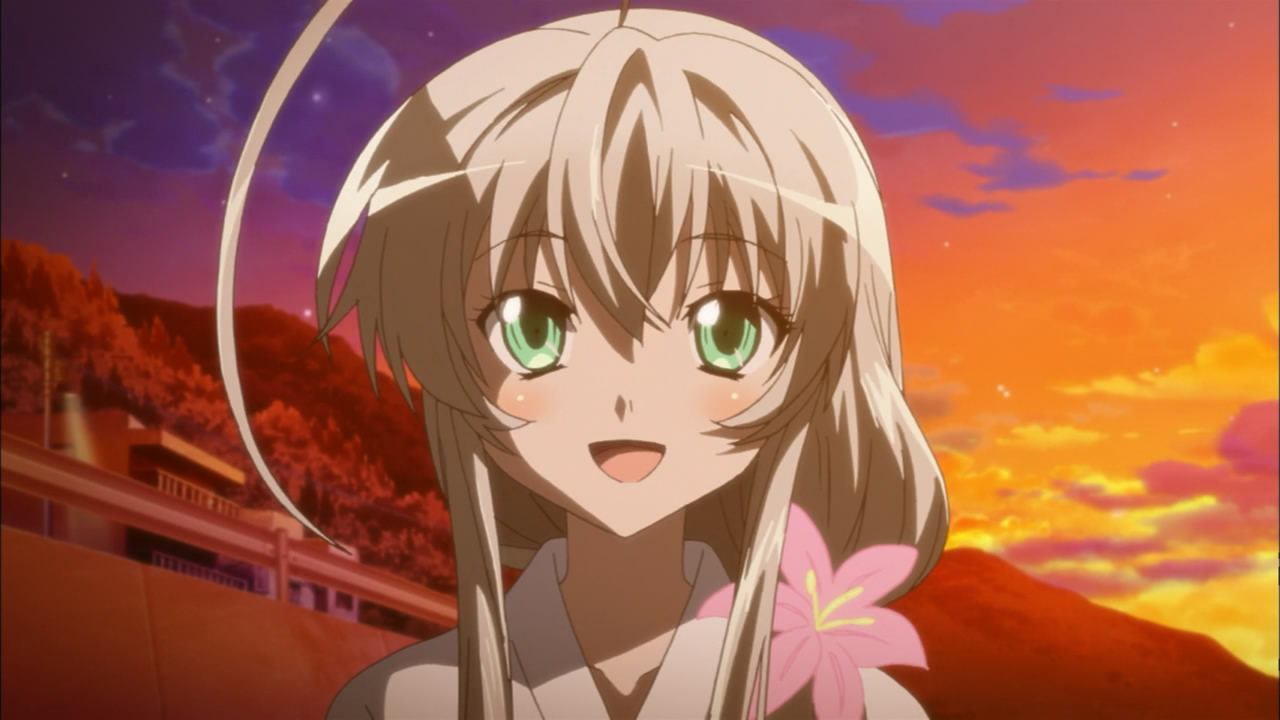Haiyore! Nyaruko-san Episode 7 References

"Yahoo!" (4:44)
This scene is referencing "Super Mario" (スーパーマリオ), a series of video games released by Nintendo (任天堂) starting from 1985. In the series, question mark blocks and brick blocks commonly appear. Nyaruko's jumping pose is referencing that of Mario (マリオ), the main character of the series, and Nyaruko also says "Yahoo!" (ヤッフー!), which is a line said by Mario when he jumps.
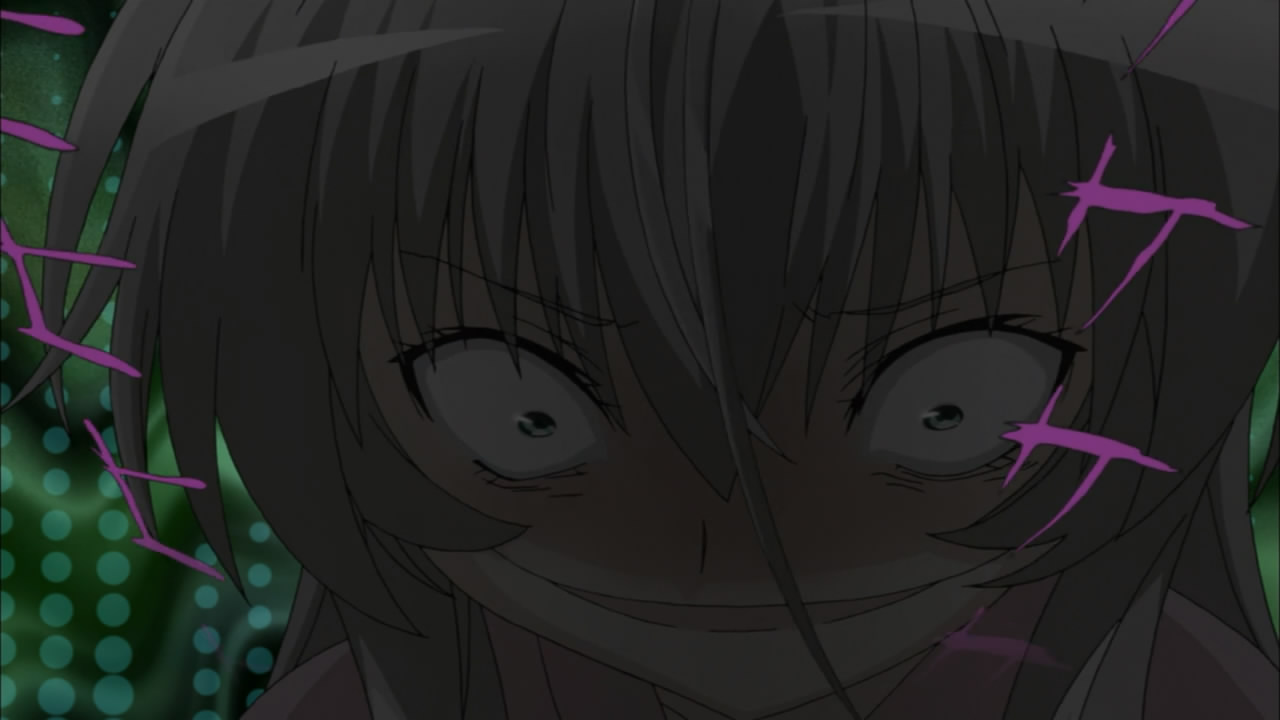
(5:17)
Nyaruko's expression appears to be referencing "Higurashi no Naku Koro ni" (ひぐらしのなく頃に), "When the Cicadas Cry", an anime series that aired in 2006. In the series, various characters have been depicted with a similar expression. Image for reference:
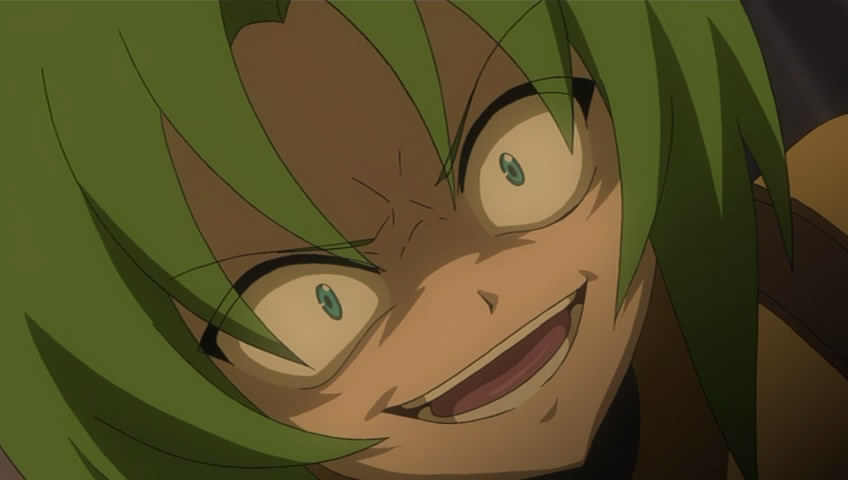
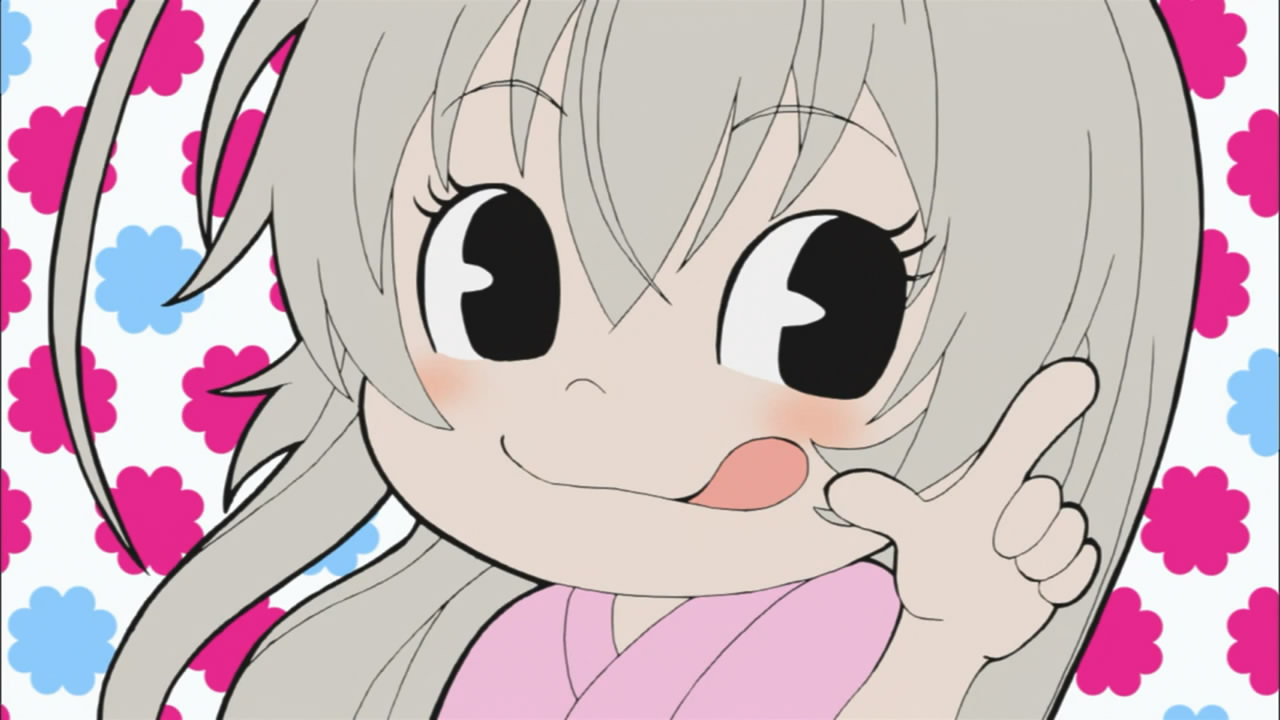
(5:23)
There are two references here:
* Nyaruko's expression is referencing Peko-chan (ペコちゃん), the mascot of the Fujiya Company (不二家).S2 Image for reference:
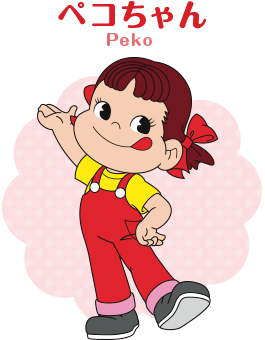
Source of image: https://www.fujiya-peko.co.jp/pekoroom/profile/
* The background motif is referencing the wrapper of "Mirukii" (ミルキー), "Milky", a type of candy and cake sold by the Fujiya Company.S2 Images for reference:

Image sources:
http://www.fujiya-kumegawa.com/whole/detail80.php
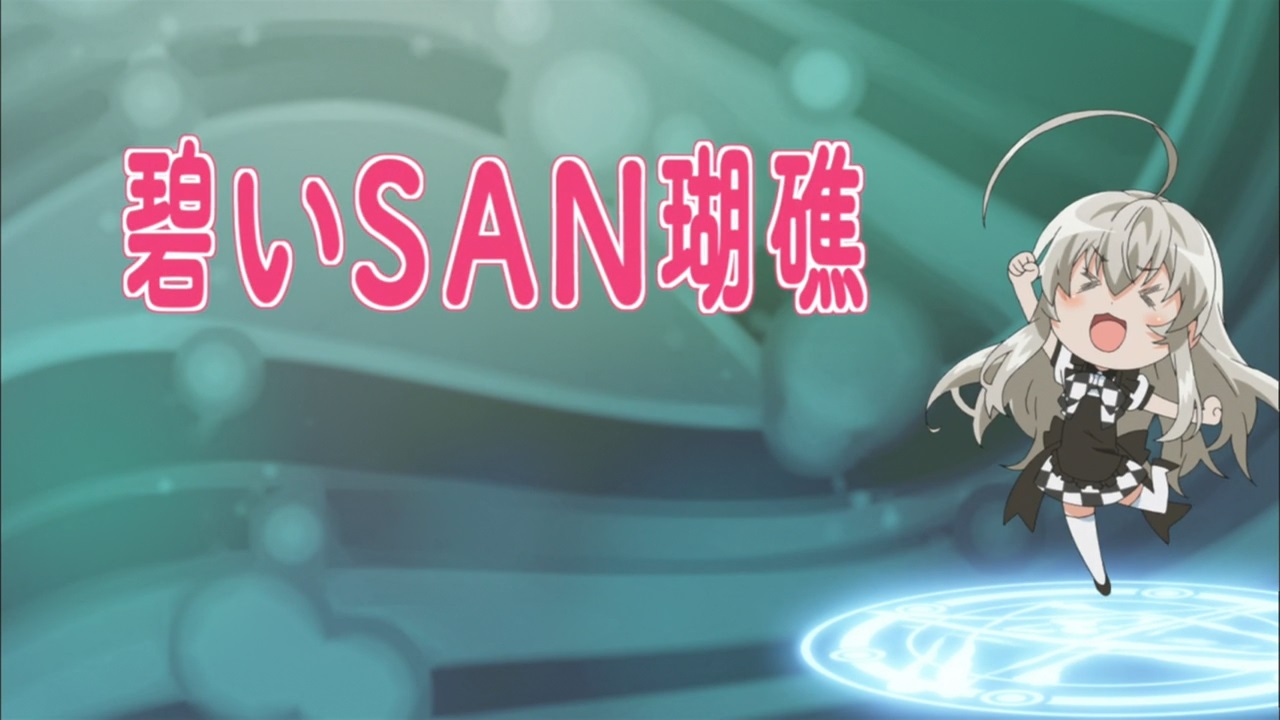
(6:02)
The title of this episode is "Aoi SAN goshou" (碧いSAN瑚礁). This is a pun on "Aoi Sangoshou" (青い珊瑚礁), which translates to "Blue Lagoon". There are two references here:
* The "SAN" in the title is referencing "Call of Cthulhu", a tabletop role playing game first published in 1981 by Chaosium. According to the "Call of Cthulhu" 6th Edition Rulebook, each player's character has a numerical parameter called "Sanity", abbreviated as "SAN", that represents the character's "flexibility and resilience to emotional trauma". This number is the upper limit for a character's Sanity Points, which represent the character's current level of sanity. While playing the game, characters can encounter sanity threatening situations that can reduce their current Sanity Points. "If an investigator's current Sanity Points drop to zero, he or she is permanently insane, and normally can no longer be played."
* This is referencing "Aoi Sangoshou" (青い珊瑚礁), "Blue Lagoon", a song sung by Matsuda Seiko (松田聖子) and released in 1980.S2
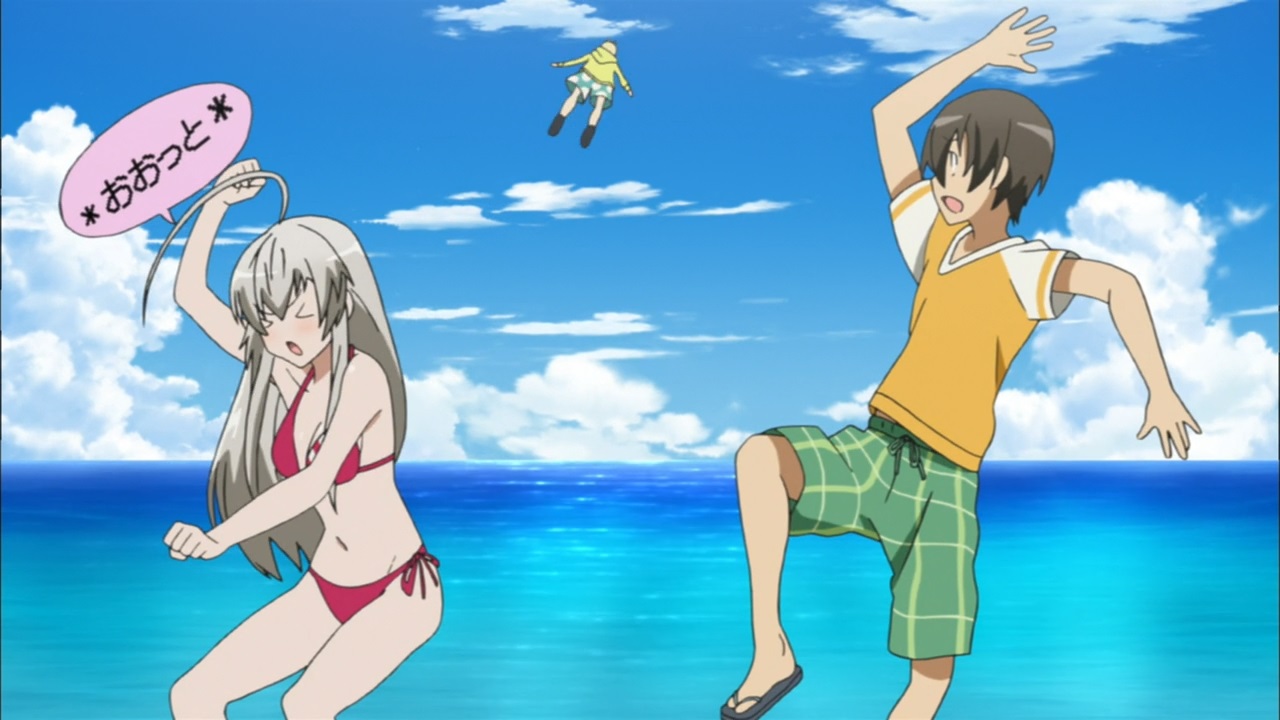
(6:43)
Nyaruko's stance is referencing Tetsuzankou (鉄山靠), a martial arts technique that attacks a target with one's shoulder. It is a part of a Chinese style of martial arts called Bajiquan (八極拳). In Japanese it is called "Hakkyokuken". In particular, Nyaruko's form is referencing how the technique is performed by Yuuki Akira (結城晶) in "Virtua Figher" (バーチャファイター), a video game released by Sega (セガ) in 1993.S1 Image for reference:
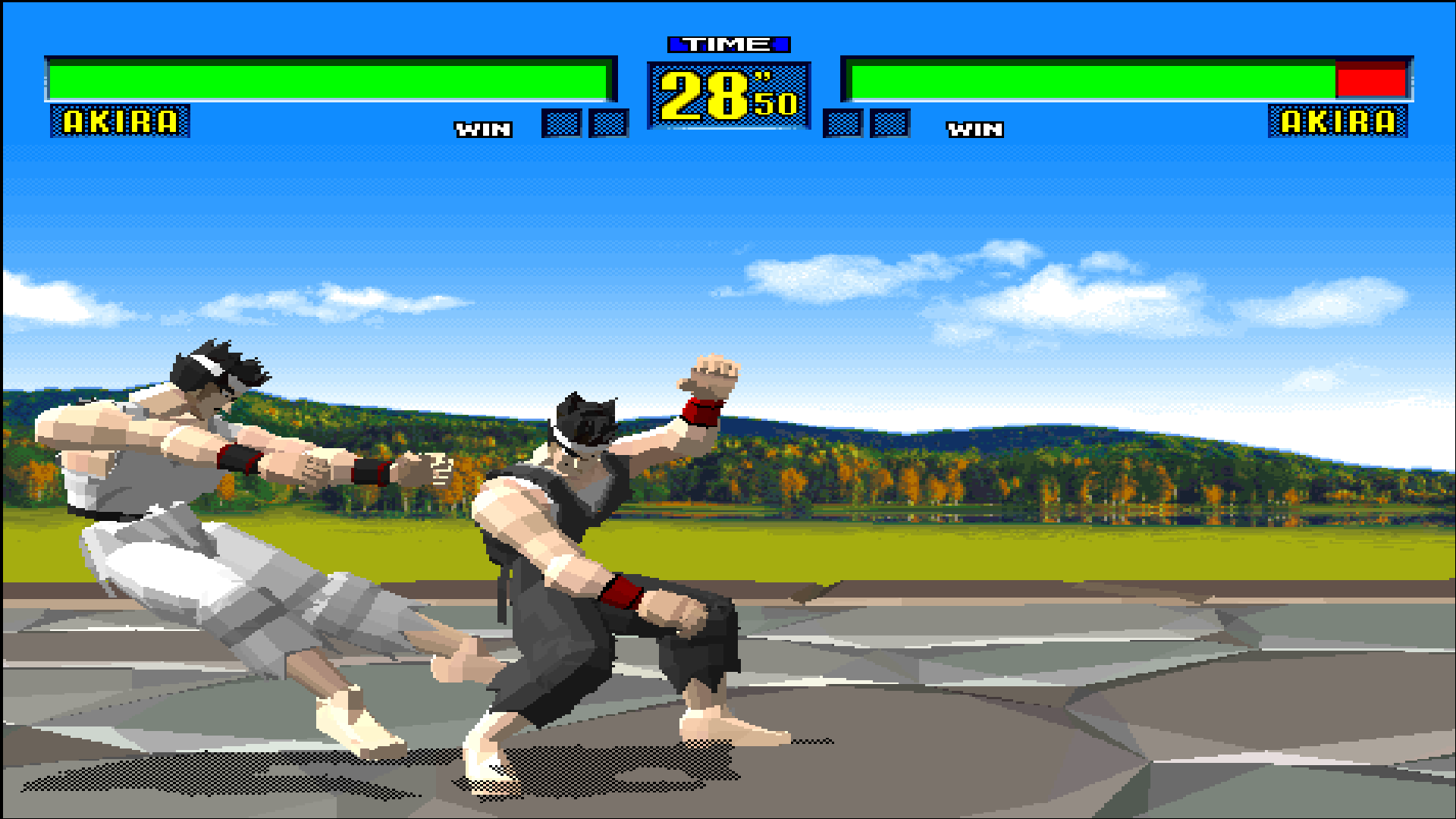
"Whoops, there's a teleporter here!" (6:44)
"He almost ended up in rock." (6:53)
Nyaruko's lines are referencing "Uizaadorii Kyouou no Shirenjou" (ウィザードリィ 狂王の試練場), "Wizardry: Proving Grounds of the Mad Overlord", a video game released in 1981.S1 In the game, a teleporter can be found in a treasure chest. When activated, it teleports the player's party to a random square on the same level. If the party teleports to a square occupied by solid rock, the party dies. Specifically, Nyaruko's first line goes, "Ootto, konna tokoro ni terepootaa ga!" (おおっと、こんな所にテレポーターが!). This is referencing how a message that can appear when the player discovers a teleporter is "Ootto! terepootaa" (おおっと!テレポーター), which translates to "Whoops! A telepoter". Nyaruko's second line goes, "Mou sukoshi de ishi no naka ni iru tokoro deshita yo" (もう少しで石の中にいるところでしたよ). This is referencing how a message that can appear when the player's party dies from teleporting into rock is "Ishi no naka ni iru!" (いしのなかにいる!), which translates to "You are in rock!". Images for reference:
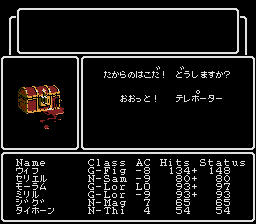
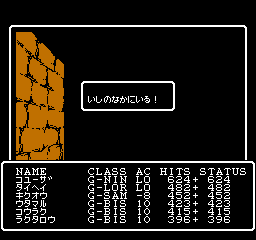
Image sources:
http://www.geocities.jp/youtakasaka/kod/kod15.html
http://numa5.blog.so-net.ne.jp/2011-10-04
On a related note, the Necronomicon from the Cthulhu Mythos appeared in "Uizaadorii Foo Waadona no Gyakushuu" (ウィザードリィIV ワードナの逆襲), "Wizardry IV: The Return of Werdna", the fourth game in the "Wizardry" (ウィザードリィ) series that was released in 1987.S4
"Our True End Route has no detours!" (7:02)
This is referencing a common element in visual novels. Many visual novels have multiple story routes that the player can read through. Also, visual novel will often have multiple endings, ranging from good to bad.
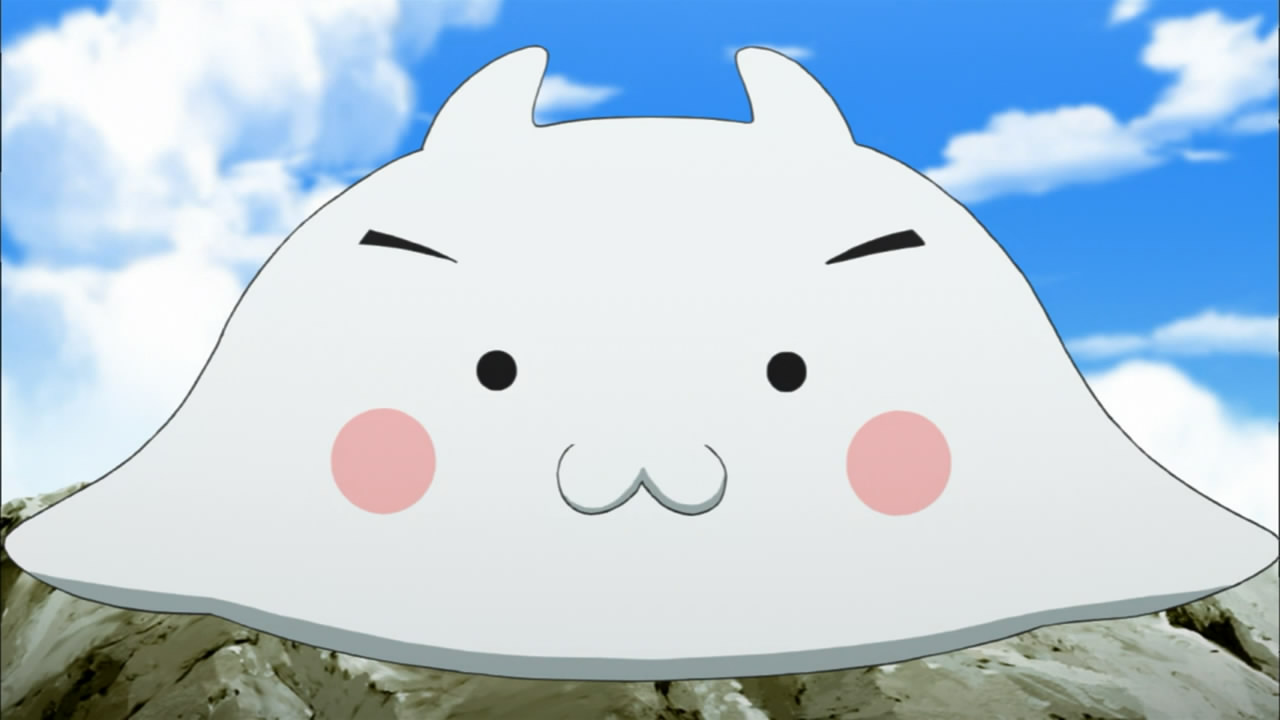
~< `・ω・´> (7:18)
Aisora sighting #1. The white creature is the Twitter profile picture of Aisora Manta (逢空万太), the author of the "Haiyore! Nyaruko-san" light novel series. Screen capture for reference:

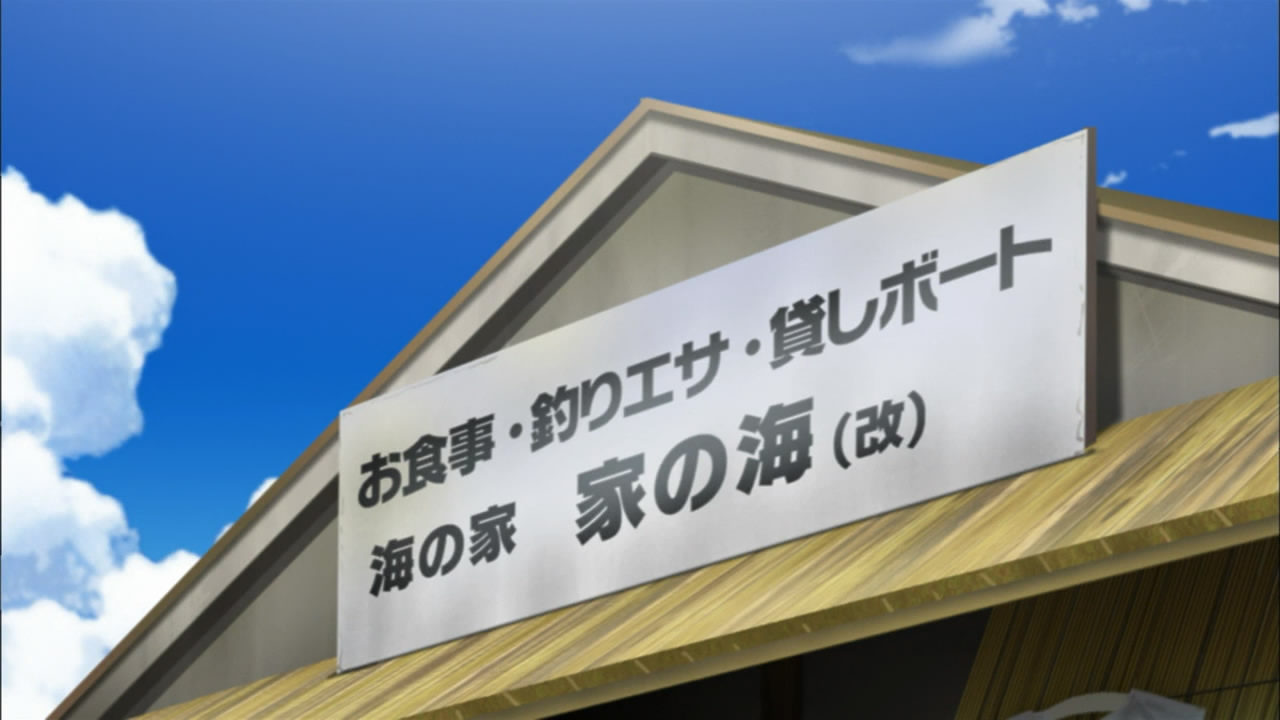
(8:07)
The text on the sign of the beach house goes as follows:
お食事・釣りエサ・貸しボートThis is referencing the same text written on a sign for a beach house that appears in "Yuri Seijin Naoko-san" (百合星人ナオコサン), "Yurian Naoko-san", a manga series written by kashmir and published starting from 2006.S4 Image for reference:
海の家 家の海(改)
Oshokuji, Tsuri Esa, Kashi Booto
Umi no Ie Ie no Umi (kai)
Food, Fishing Bait, Boat Rentals
House of the Sea Sea of the House (revised)
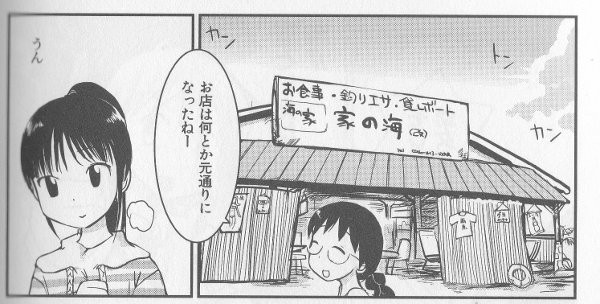
Source of image: http://f.hatena.ne.jp/servitors/20120524190128
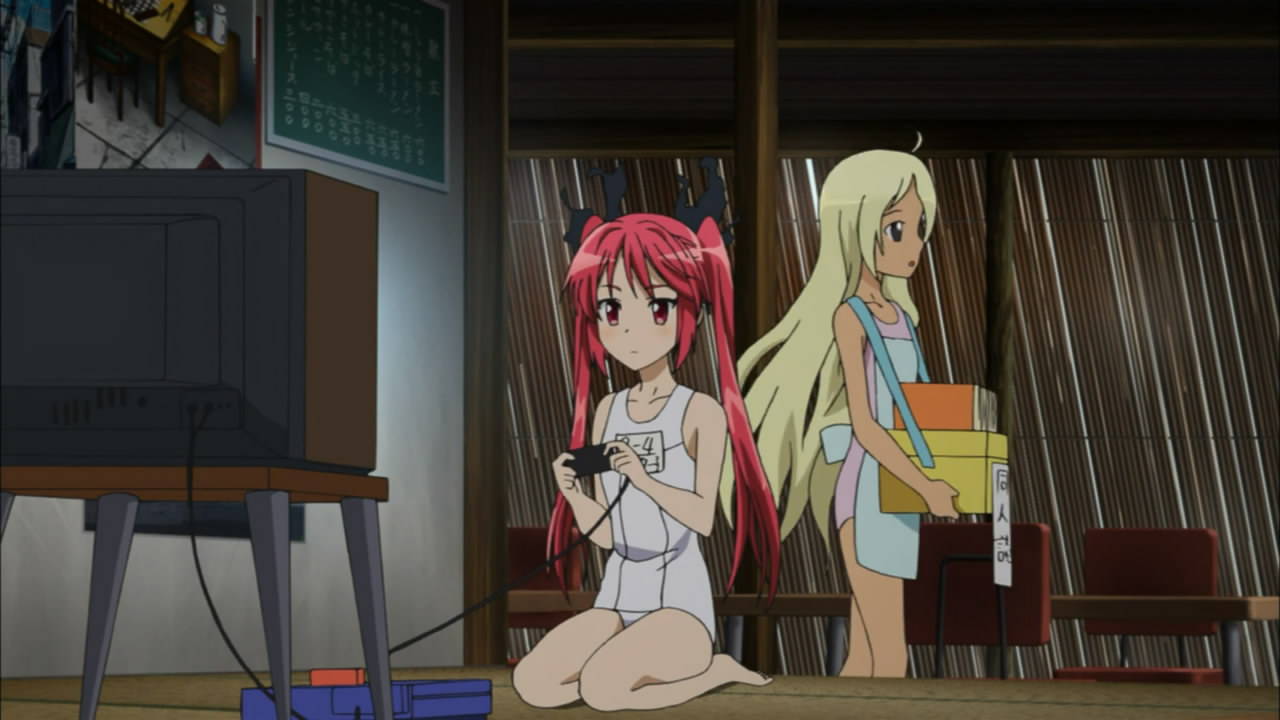
(8:20)
The girl in the background resembles Jashin-chan (邪神ちゃん) from "Yuri Seijin Naoko-san" (百合星人ナオコサン), "Yurian Naoko-san".S4 In the series, Jashin-chan works at the above mentioned beach house. Image for reference:
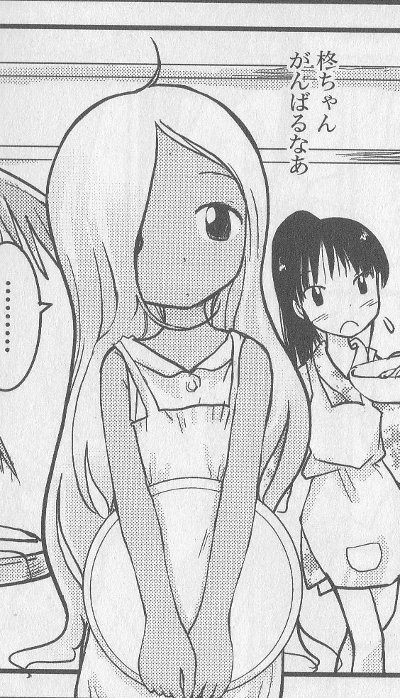
Source of image: http://f.hatena.ne.jp/servitors/20120524185256
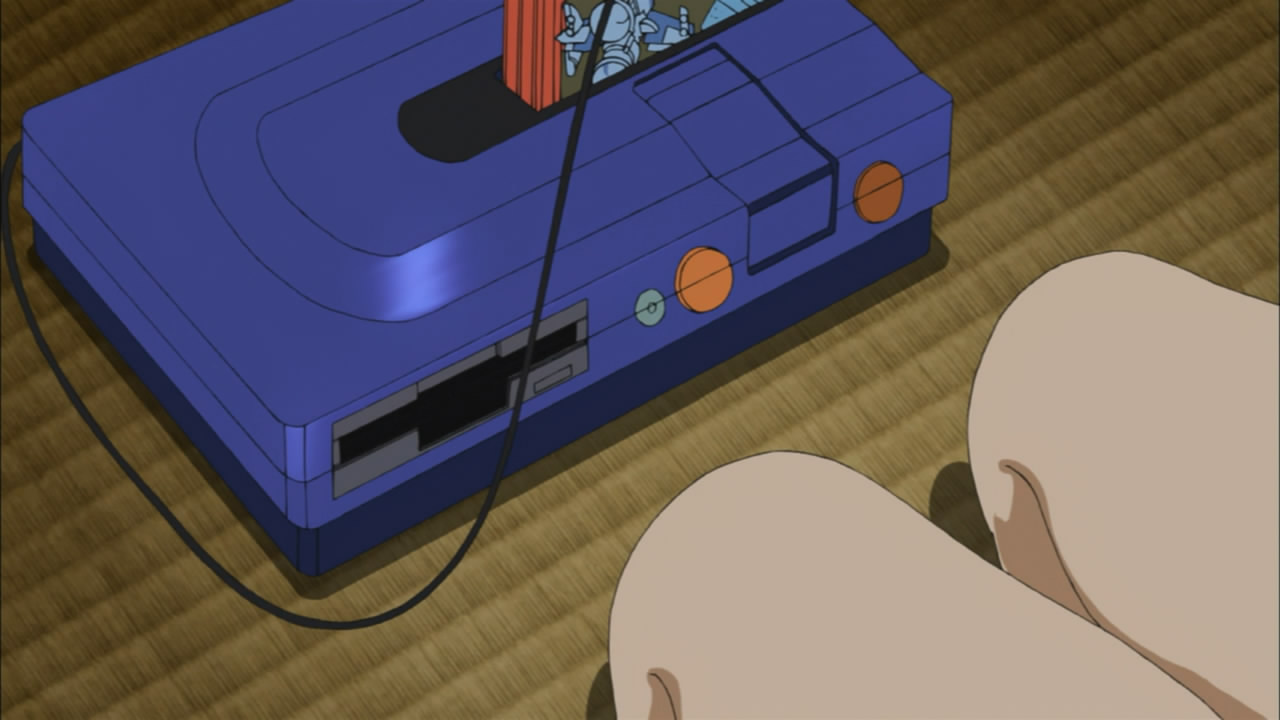
(8:44)
The device here is based on the Twin Famicom (ツインファミコン), a video game console released by Sharp (シャープ) in 1986.S1 Image for reference:
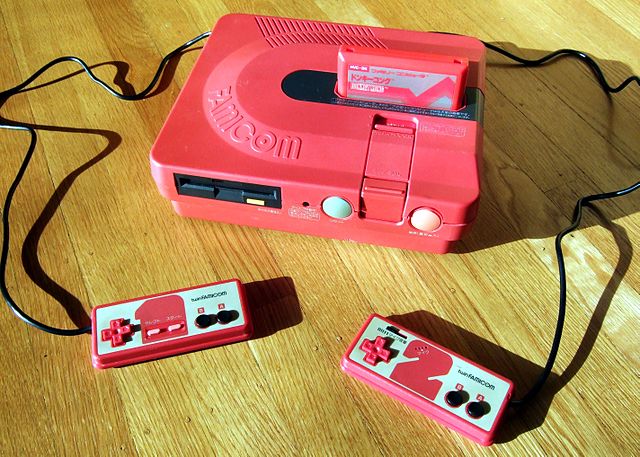
Source of image: https://en.wikipedia.org/wiki/File:CurvyFamicom.jpg
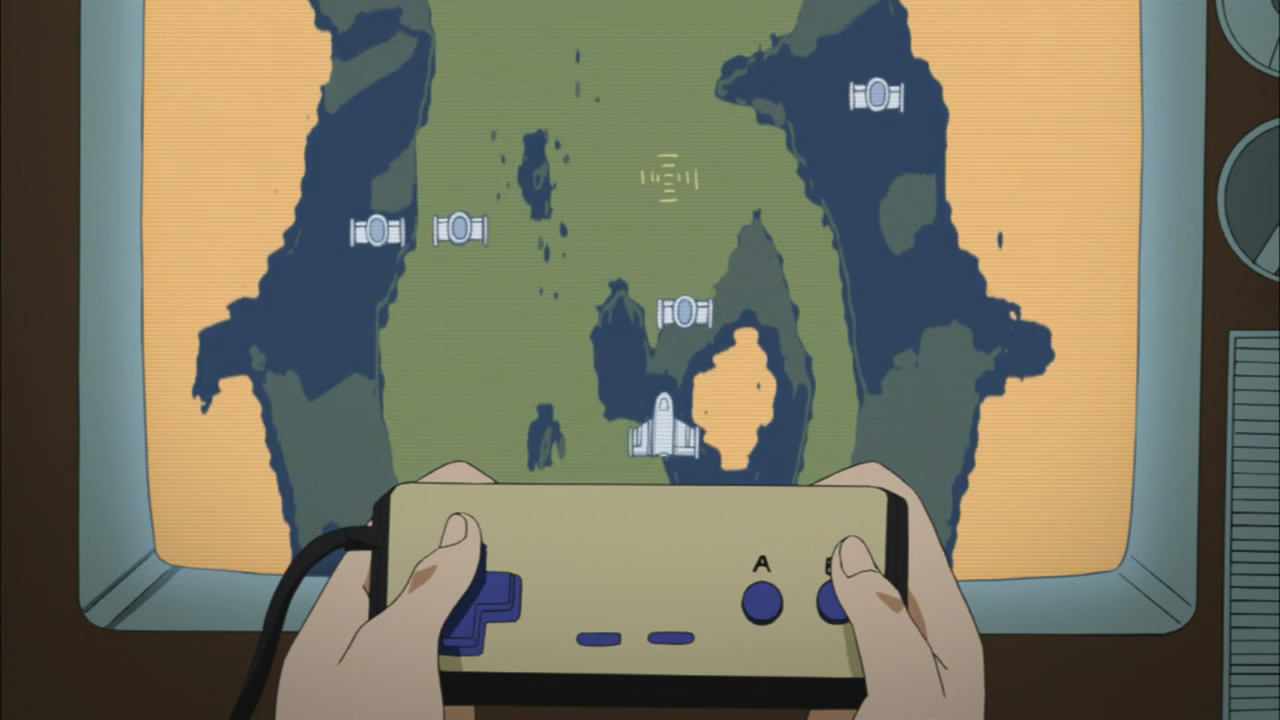
(8:53)
The game Cthuko is playing is referencing "Suupaa Zebiusu Ganpu no Nazo" (スーパーゼビウス ガンプの謎), "Super Xevious The Mystery of Gamp", a video game released by Namco (ナムコ) in 1986.S1 Image for reference:
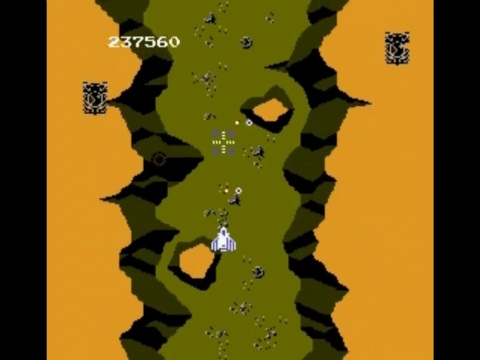
Video for reference: https://youtube.com/watch?v=_87JvPQZkxI
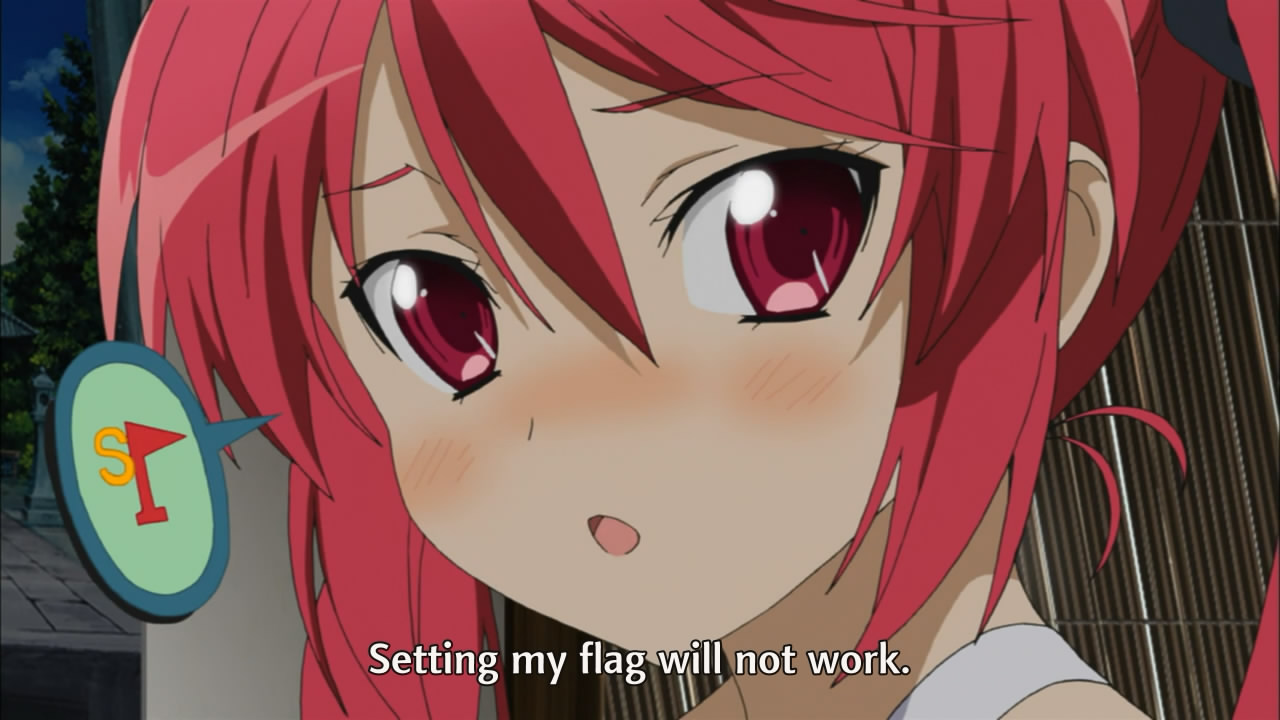
"Setting my flag will not work." (9:33)
There are two references here:
* The flag that appears here is referencing the Special Flag (スペシャルフラッグ) from "Rally-X" (ラリーX), a video game released by Namco (ナムコ) in 1980. Image for reference:
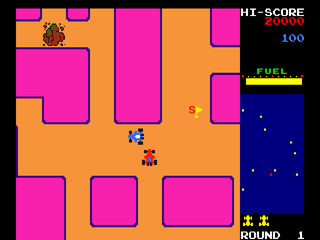
Source of image: http://www.mobygames.com/game/playstation/namco-museum-vol-1/screenshots/gameShotId,403849/
* As mentioned in episode 5, the "flag" Cthuko mentions is referencing a common element in visual novels. Often times in such games there will be decision points at which the player has to choose how to proceed. Certain decisions, at times a series decisions, of will cause a "flag" to get set which will later cause an event to occur.
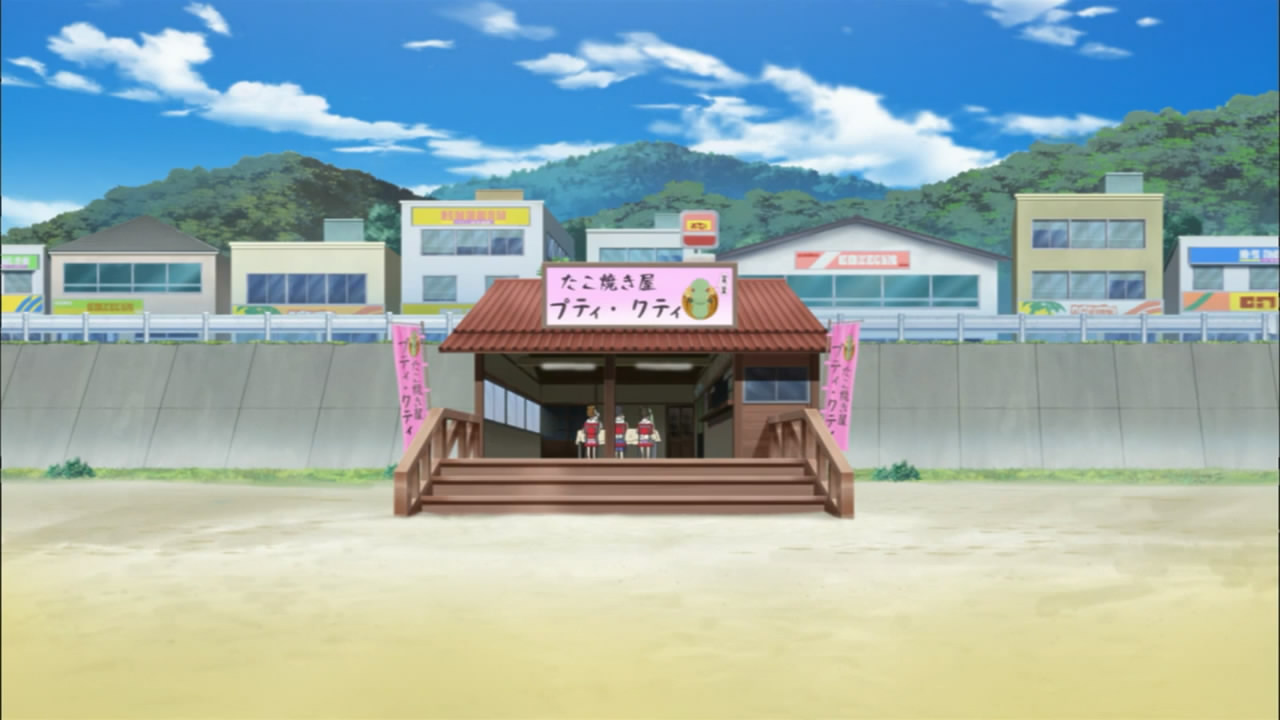
(9:49)
There are two references here:
* The name of Luhy's restaurant is Puti Kuti (プティ・クティ). This is the name of the mascot character from "Moe Moe Kutouruu Shinwa Jiten" (萌え萌えクトゥルー神話事典), "Lovely Cthulhu Mythos Encyclopedia", a book published in 2009.S4
* The creature that appears on the sign is referencing Cthulhu from the Cthulhu Mythos. In particular, the depiction here is based on the appearance of Puti Kuti from the book mentioned above.S4 Image for reference:
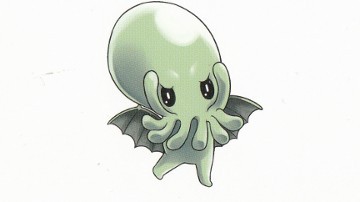
Source of image: http://f.hatena.ne.jp/servitors/20120524190732
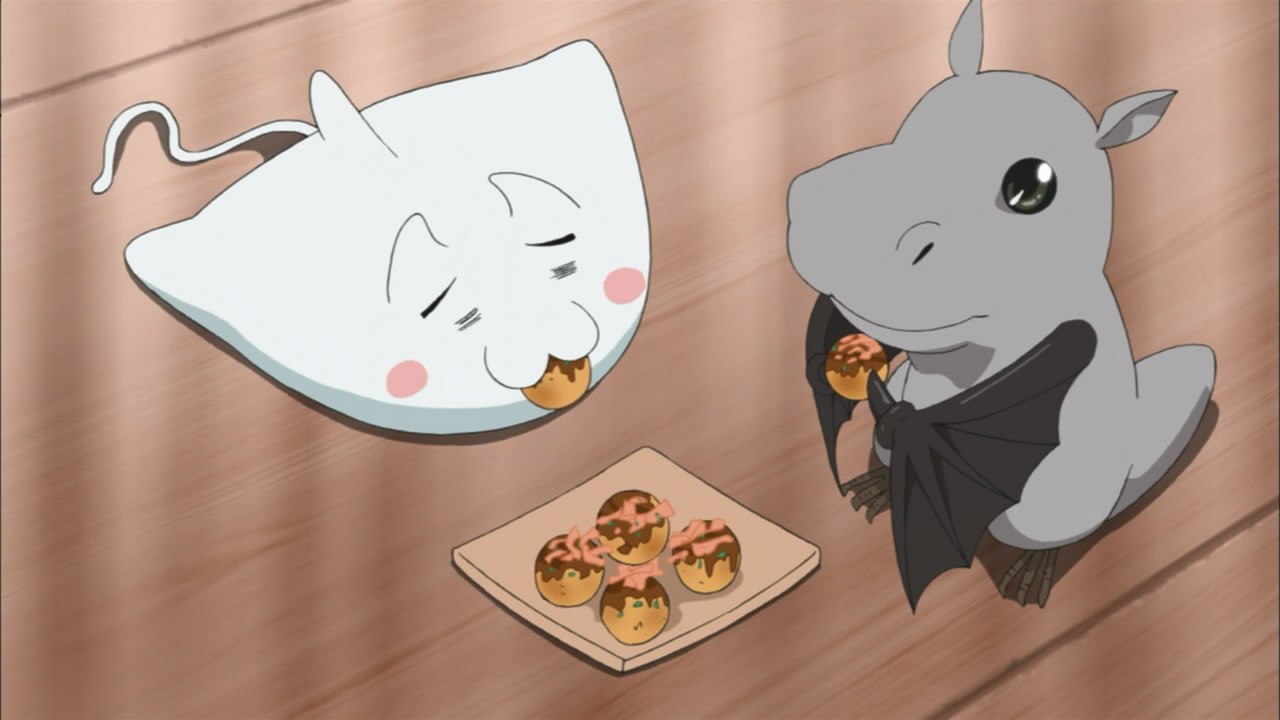
~< `=ω=´> (10:30)
Aisora sighting #2.
"Cthulhu and Hastur have never gotten along." (10:45)
As mentioned in episode 6 at 7:31, this is referencing how Cthulhu and Hastur are antagonistic towards each other in the Cthulhu Mythos. Evidence of opposition between the two is mentioned in various texts, such as "The Return of Hastur", a short story written by August Derleth and first published in 1939, and "The Trail of Cthulhu", a book containing a series of interconnected short stories written by August Derleth and first published in 1962.
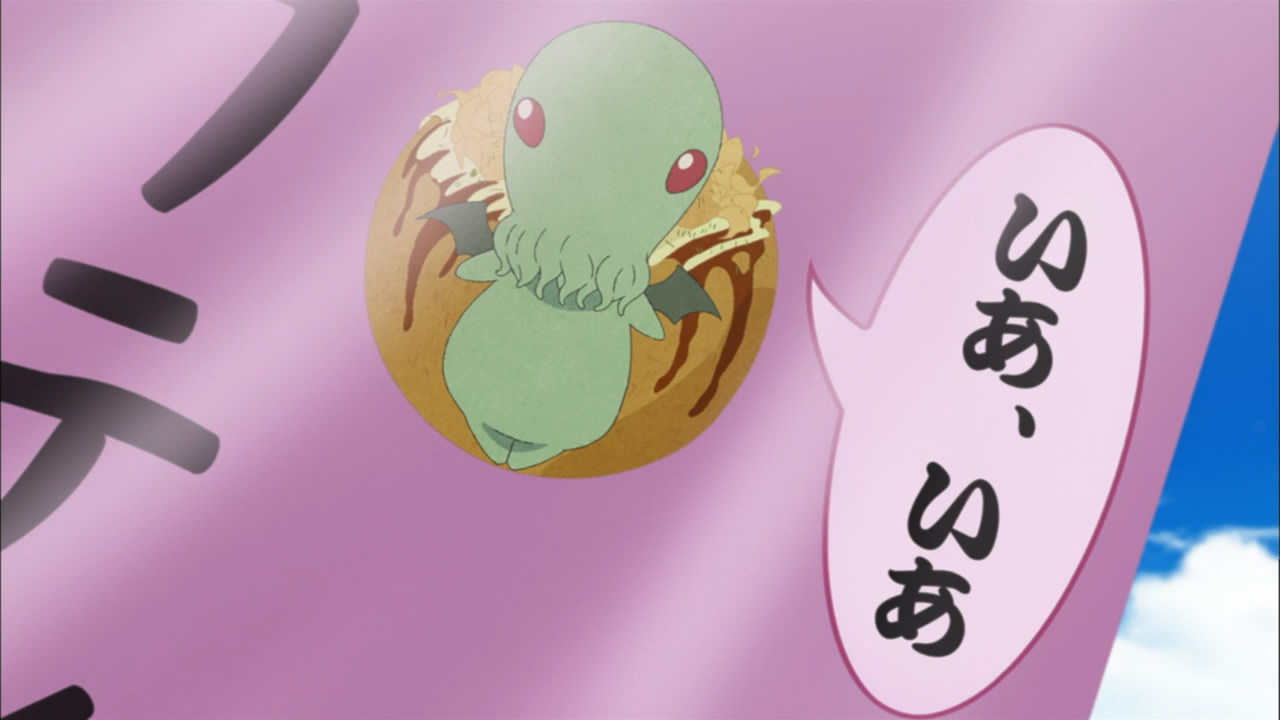
(11:22)
There are two references here:
* As mentioned above, the creature depicted is Cthulhu from the Cthulhu Mythos and its appearance is based on that of Kuti Puti from "Moe Moe Kutouruu Shinwa Jiten".
* The Japanese text reads "Ia, Ia" (いあ、いあ). As mentioned in episode 1 at 3:20, "Iä" is a term that is used in the Cthulhu Mythos, often in relation to the fantastic creatures that appear in the mythos. In "The Shadow Over Innsmouth", a story written by H. P. Lovecraft and first published in 1936, a chant using the term goes as follows:
"Iä! Iä! Cthulhu fhtagn! Ph’nglui mglw’nafh Cthulhu R’lyeh wgah-nagl fhtagn"
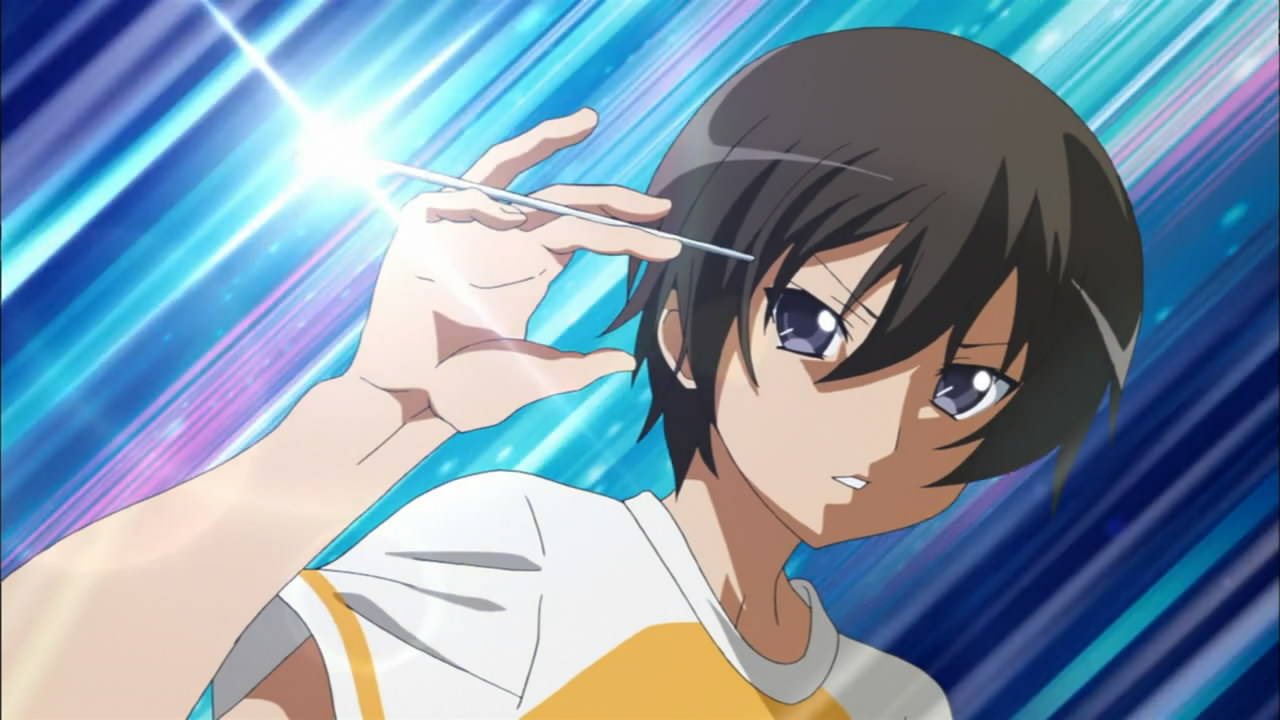
(11:50)
Mahiro's pose in this scene is mimicking that of Kazari Shokunin no Hide (飾り職人の秀), Decorations Craftsman Hide, from "Hissatsu Shigotonin" (必殺仕事人), roughly "Working Men Killers", a Japanese TV drama that aired from 1979 to 1981 and is part of the "Hissatsu" series (必殺シリーズ), "Certain Kill" series.S2
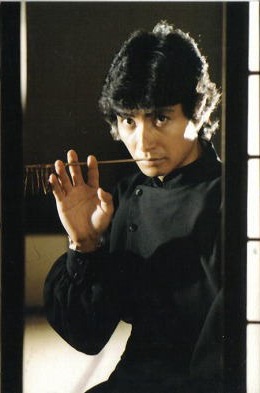
Source of image: http://www1.odn.ne.jp/cfp46850/newpage36.htm
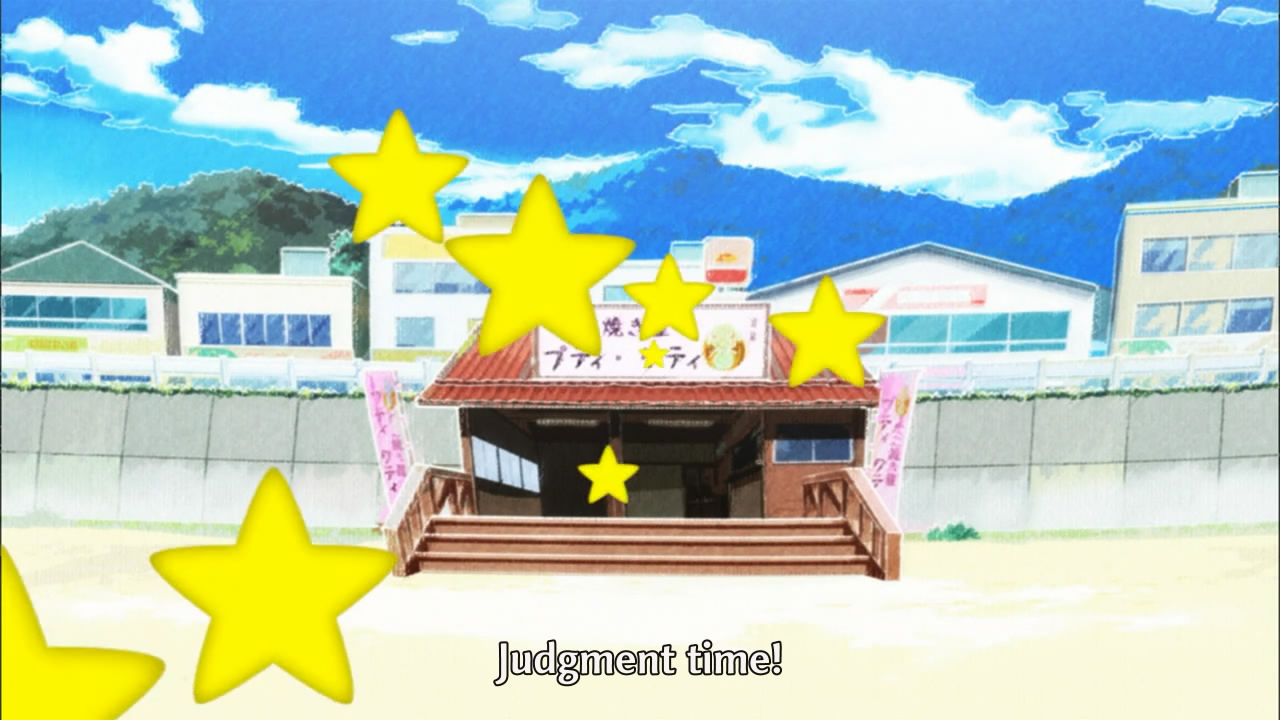
"Judgement time!" (11:52)
There are two references here:
* The Japanese line is "Jajjimento Taimu!" (ジャッジメントタイム!). This is referencing "Tokusou Sentai Dekarenjaa" (特捜戦隊デカレンジャー) "Special Police Squadron Dekaranger", a Japanese TV show about a squadron of costumed super heroes that aired from 2004 to 2005.S1 "Judgement Time" is a catchphrase announced when the Dekarangers contact the supreme court of the universe in order to request judgement on a target.
* "Judgement time!" is a line in lyrics to "Middonaito Dekarenjaa" (ミッドナイト デカレンジャー), "Midnight Dekaranger", the ending theme song to "Tokusou Sentai Dekaranger". The stars flying into the foreground mimics the same effect in the ending sequence to "Tokusou Sentai Dekaranger".S3 Image for reference:
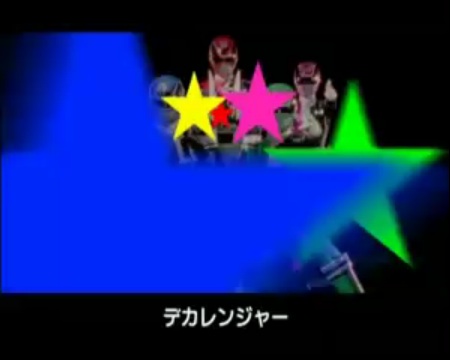
"Mahiro, you're as radiant as the sun. You're bold and invincible!" (12:27)
The Japanese line is "Mahiro-san ttara nichirin no kagayaki, motoi daitaan desu ne!" (真尋さんったら日輪の輝き、もといダイターンですね!). The word "daitaan" (ダイターン) is a pun on "daitan" (大胆), which means "daring" or "bold" in Japanese. This is referencing "Muteki Kikoujin Daitaan 3" (無敵鋼人ダイターン3), "Invincible Steel Man Daitarn 3", an anime series that aired from 1978 to 1979. In addition, the phrase "nichirin no kagayaki" (日輪の輝き), "radiance of the sun", is referencing a catch phrase said by Haran Banjou (破嵐万丈) in this series.S1 His line goes as follows:
「この日輪の輝きを恐れぬのならば、かかってこい!!」
"Kono nichirin no kagayaki wo osorenu no naraba, kakatte koi!!"
"If you don't fear the radiance of the sun, then bring it on!!"
"I will break the watermelon apart with my kicks and martial arts." (12:37)
There are two references here:
* "Kick" and "Martial Arts" are skills in "Call of Cthulhu", a tabletop role playing game first published in 1981 by Chaosium.S2 Skills list from the "Call of Cthulhu" 5th edition rulebook for reference.
* The Japanese line is "Kikku to maasharu aatsu de suika wo keriwarimasu ne" (キックとマーシャルアーツでスイカを蹴り割りますね). This is referencing a line said by Higuchi Sayaka (樋口さやか) in "Ruruie Antiiku" (るるいえあんてぃーく), "R'lyeh Antique", an RPG replay book based on the "Call of Cthulhu" RPG that was written by Uchiyama Yasujirou (内山靖二郎) and published in 2009.S4 Sayaka's line goes as follows:
「さやか:次は私の番ですね。えーと、私は〈聞き耳〉でみんなの指示をよく聞いて〈キック〉と〈マーシャルアーツ〉でスイカを蹴り割ります!」Image for reference:
Sayaka: Tsugi ha watashi no ban desu ne. Eeto, watashi ha "kikimimi" de minna no shiji wo yoku kiite "kikku" to "maasharu aatsu" de suika wo keriwarimasu!
Sayaka: It's mine turn next, huh? Um, I'll "listen" really closely to everyone's instructions, and break the watermelon apart with my "kick" and "martial arts"!
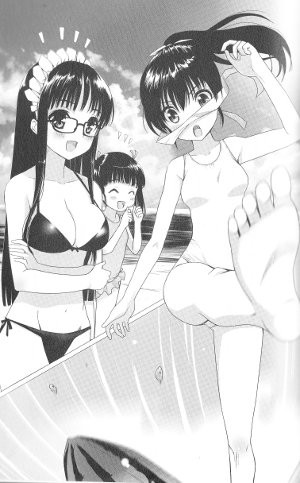
Source of image: http://f.hatena.ne.jp/servitors/20120523213707
The context for the above scene is that Sayaka and company are playing a popular Japanese beach game in which one participant is blindfolded and usually armed with a bat or a stick. He or she is then directed towards a watermelon by the other participants and attempts to break the watermelon apart. As a side note, "Listen" is another skill from the "Call of Cthulhu" RPG, which is why it is in quotes.
"Because we're like two wings of a bird." (12:57)
"We're like two trees that have grown into each other." (13:07)
There are four references here:
* The first line in Japanese is "Watashi to Mahiro-san ha hiyoku no tori desu shi" (私と真尋さんは比翼の鳥ですし). "Hiyoku no tori" (比翼の鳥) is a Japanese expression that refers to a pair of male and female birds that always flying together and is used to describe a happily married couple. There are various interpretations of the expression, all holding the meaning of togetherness, such as each bird having one eye and one wing such that together they make a whole or the pair being a single bird having two heads.
* The second line in Japanese is "Watashi to Mahiro-san ha renri no eda desu shi" (私と真尋さんは連理の枝ですし). "Renri no eda" is a Japanese expression that refers to trees with entwined branches and is used to describe an intimate relationship between lovers.
* The above two expressions can be put together to form the term "hiyokurenri" (比翼連理), which is used to mean "marital vows".S2
* These lines are referencing a line said by Al Azif (アル・アジフ) in "Zanma Taisei Demonbein" (斬魔大聖デモンベイン), "Deus Machina Demonbane", a visual novel based on the Cthulhu Mythos that was released by Nitroplus (ニトロプラス) in 2003.S2 Her original line goes as follows:
「我等は戦友。我等は盟友。我等は比翼の鳥。我等は連理の枝。」Images for reference (left is PC version, right is PS2 version):
"Warera ha senyuu. Warera ha meiyuu. Warera ha hiyoku no tori. Warera ha renri no eda."
"We are comrades. We are sworn friends. We are two halves of a whole. We are inseparable."
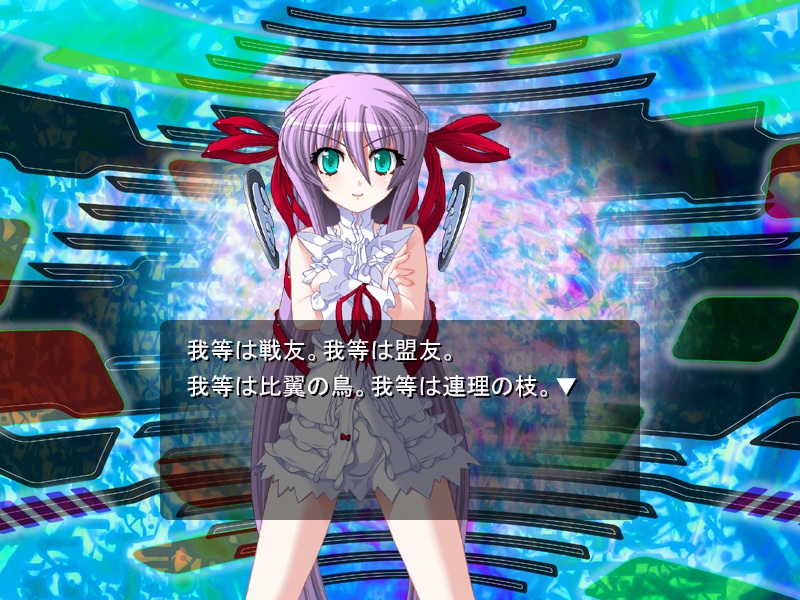
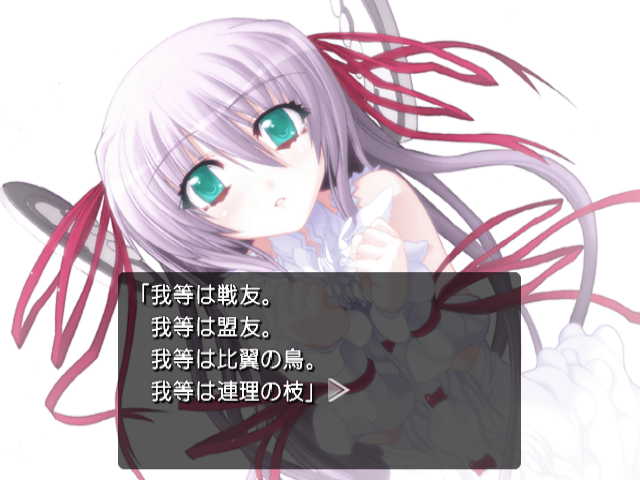
Video for reference: https://youtube.com/watch?v=jyae0iR9onQ

(14:04)
Nyaruko's appearance is referencing that of Yabuki Joe (矢吹丈) in volume 20 of "Ashita no Joe" (あしたのジョー), "Tomorrow's Joe", a manga series written by Kajiwara Ikki (梶原一騎) and published from 1968 to 1973.S1 Image for reference:

"Sorry, there won't be any wardrobe malfunctions!" (14:08)
The Japanese line is "Porori ha nai yo!" (ポロリはないよ!), which more literally means "There will not be any swimsuits falling off!". This is a reference to the Japanese variety show "Doki! Marugoto Mizugi! Onna Darake no Suitei Taikai" (ドキッ!丸ごと水着!女だらけの水泳大会). On the show the participants will wear swimsuits and play various games at a pool. The catch phrase "Porori mo aru yo!" (ポロリもあるよ!), "There will also be swimsuits falling off!", was once used on the show. It has since become a popular phrase.S1
"The rats in the walls..." (14:25)
The Japanese line is "Kabe no naka ni nezumi ga" (壁のなかの鼠が). This is referencing "The Rats in the Walls", a short story written by H. P. Lovecraft and first published in 1924.S1 The title of the Japanese translation of this story is "Kabe no Naka no Nezumi" (壁のなかの鼠).
"The window! The window!" (14:27)
The Japanese line is "Mado ni! Mado ni!" (窓に!窓に!). This is referencing "Dagon", a short story written by H. P. Lovecraft and first published in 1919.S1 The last words written in this story are "The window! The window!". In the Japanese translation of this story, the last words written are "Mado ni! Mado ni!" (窓に!窓に!).
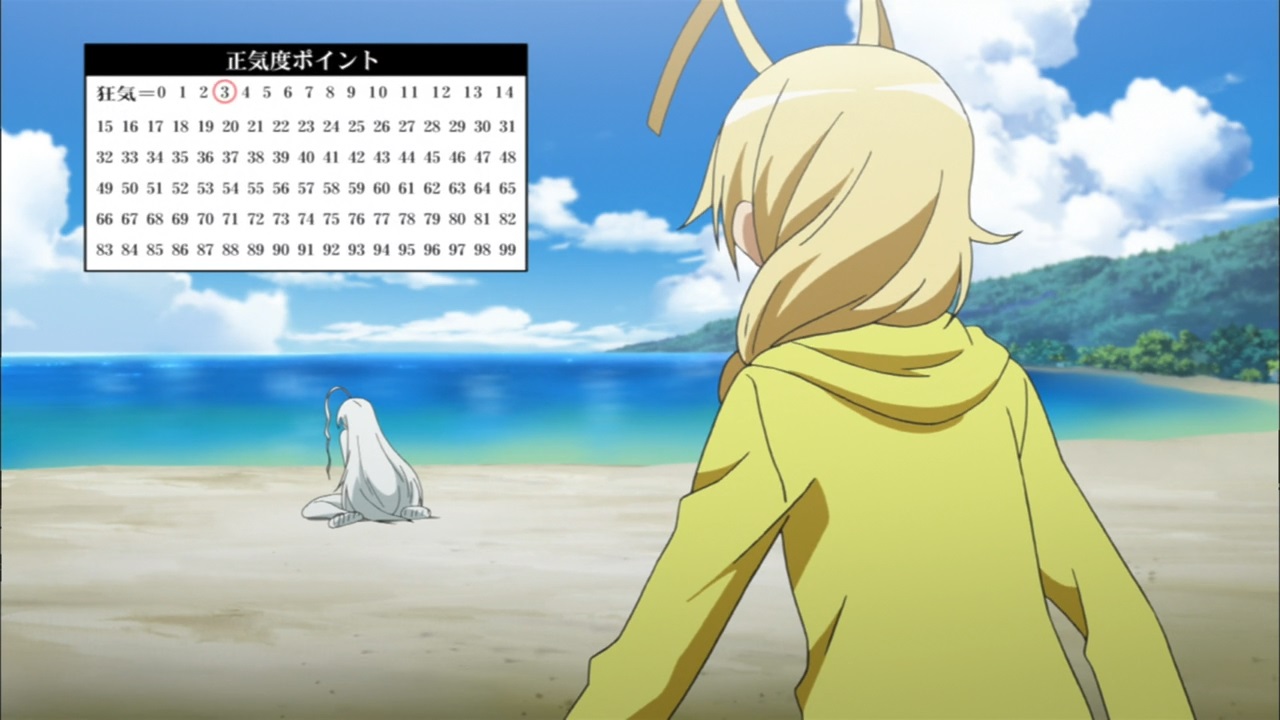
"Nyaruko's sanity points have almost reached zero!" (14:31)
"SAN chi" (SAN値), "sanity points", is a parameter that characters have in the "Call of Cthulhu" role playing game. If a character's sanity points drop to zero, the character is permanently insane and normally can no longer be played. The sanity table from the "Call of Cthulhu" character sheet also appears here. On a related note, Nyaruko's sanity points are at 3 in the scene, which is a pun on SAN, an abbreviation of "sanity", since the number 3 in Japanese is pronounced as "san". Here is a character sheet from the rulebook for the 5th edition of the "Call of Cthulhu" RPG for reference:
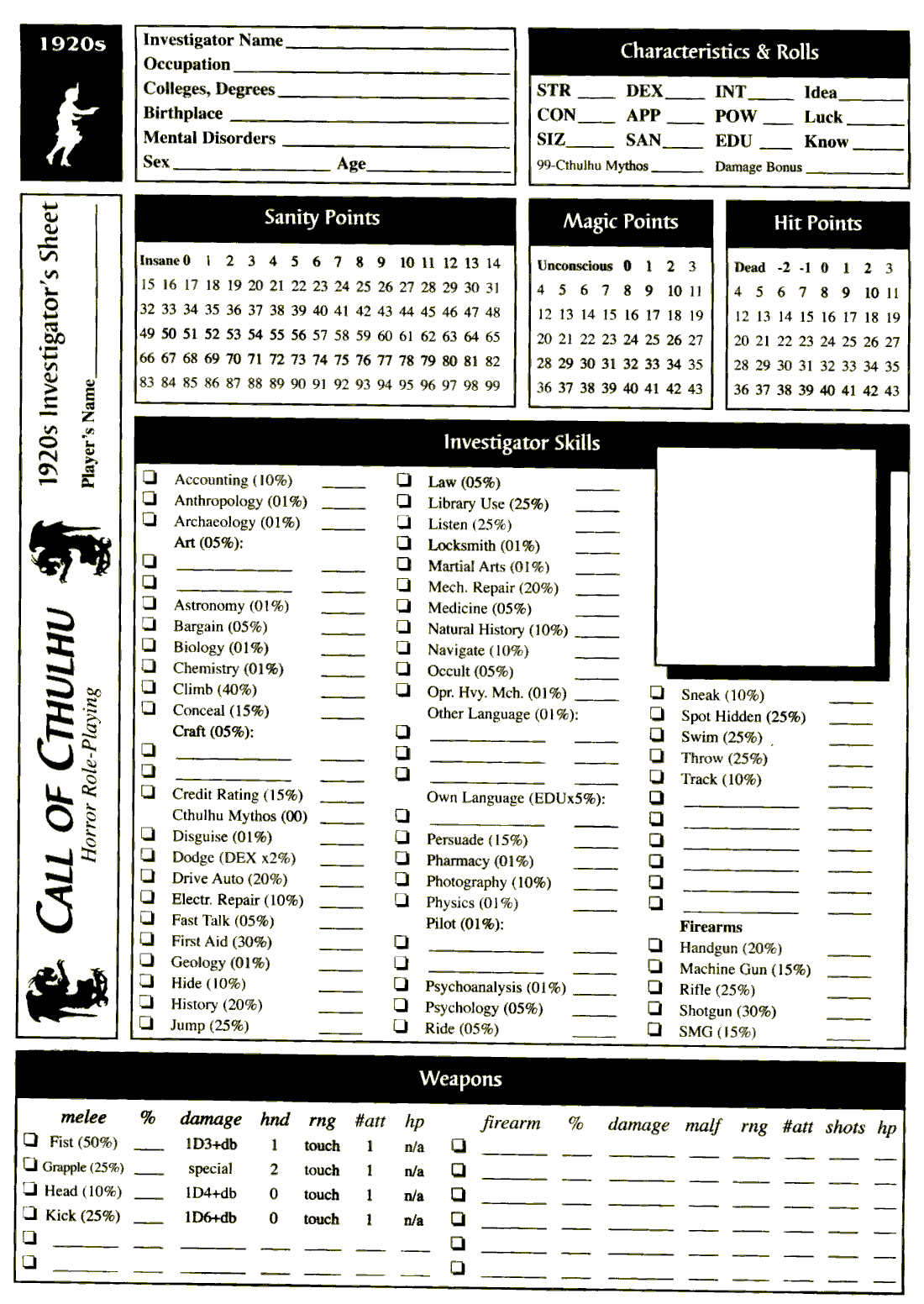
"I'll melt you with the technique only I can use." (14:47)
The Japanese line is "Watashi dake ga tsukaeru tekunikku de, tokashi tsukushite" (私だけが使えるテクニックで、溶かしつくして). This referencing a line in the lyrics to "Eejento Yoru wo Yuku" (エージェント夜を往く), "The Agent Departs at Night", a song sung by Hirata Hiromi (平田宏美) as Kikuchi Makoto (菊地真) and released in 2005.S1 This song is used in "THE IDOLM@STER" (アイドルマスター), a video game developed by Metro (メトロ) and published by Namco (ナムコ) in 2005. The original line goes, "Anata dake ga tsukaeru tekunikku de tokashi tsukushite" (あなただけが使えるテクニックで溶かしつくして), which translates to "Melt me with the technique only you can use".
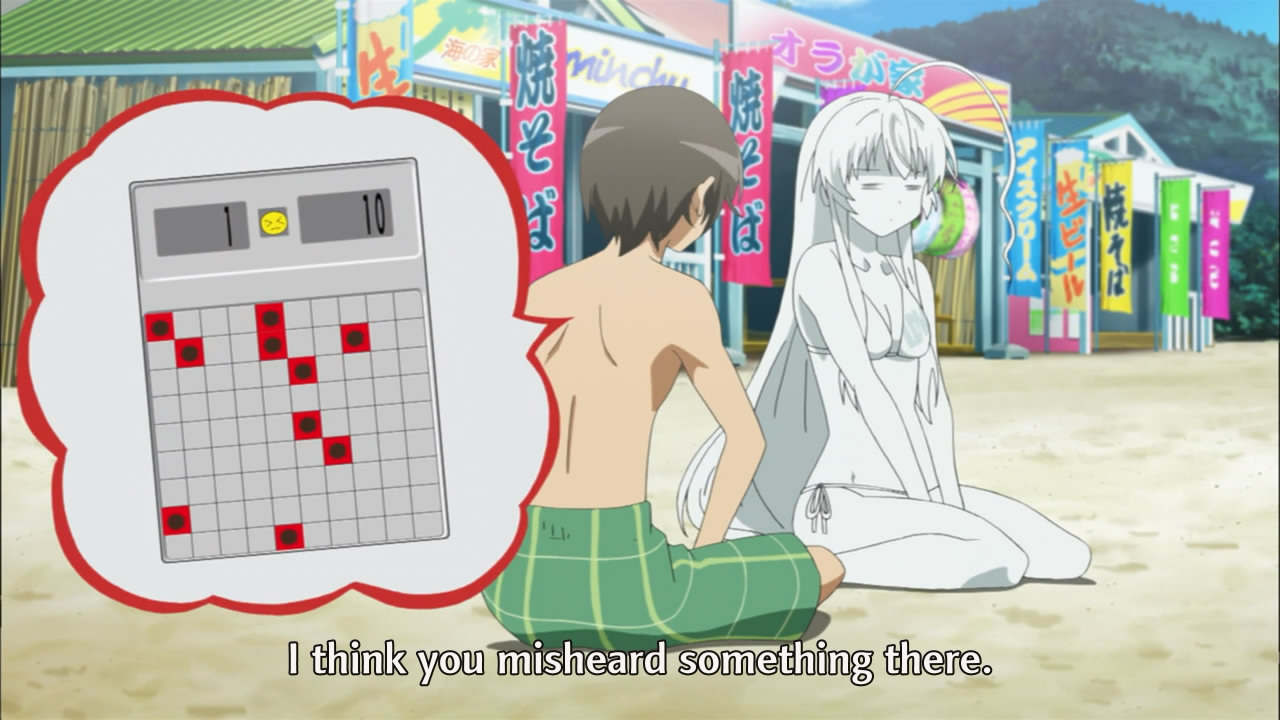
"Mahiro said I'm not his sweetheart. He said 'you're not minesweeper'." (15:43)
"I think you misheard something there." (15:47)
Nyaruko's line is related to when, at 13:39, Mahiro says, "You're not my sweetheart". The Japanese line is "Kirai da zo" (嫌いだぞ), which more literally means "I dislike you". Here Nyaruko says, "Mahiro-san ga kirai tte, eigo de ui to main" (真尋さんが嫌いって、英語で言うマイン), which more literally means "Mahiro said 'dislike', 'mine' in English". This is a pun since the same pronunciation "kirai" is used for both 「嫌い」 to mean "dislike" as well as 「機雷」 to mean "mine", the explosive weapon. Mahiro follows up to say "Sore ha kirai da" (それは機雷だ), which translates to "That's a mine".S2 The image that appears next to Mahiro is of "Minesweeper", a game in which the player tries to uncover all the mines hidden on the game board without setting any off. Image for reference:
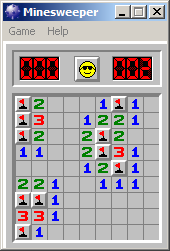
On a side note, the "Minesweeper" board that appears in the scene is depicting the scenario of the player losing on the very first move of the game, which is impossible in a standard game of "Minesweeper". Here is a website describing the first click behavior of Windows "Minesweeper": http://www.techuser.net/mineclick.html
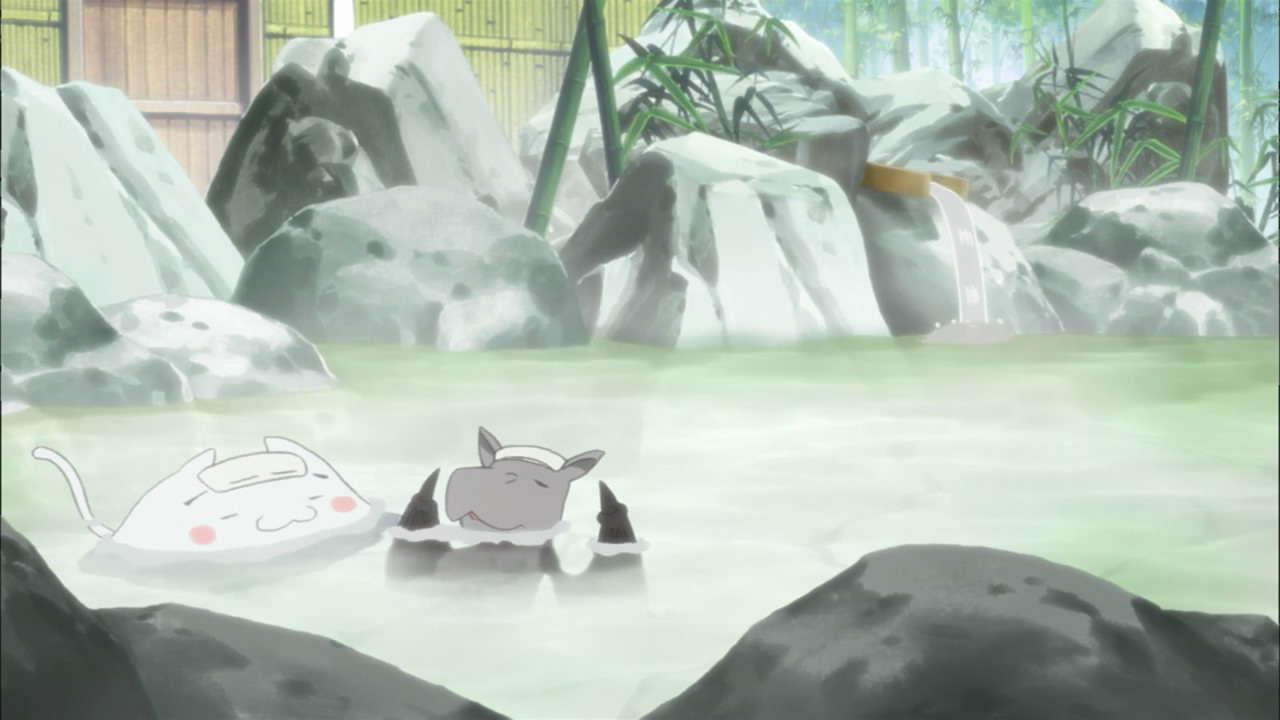
~< `-ω-´> (17:30)
Aisora sighting #3.

(17:55)
There are two references here:
* The tower that appears here is referencing "The Black Stone", a short story written by Robert E. Howard and first published in 1931.S4 In the story, there is a black stone that is described as follows:
"It was octagonal in shape, some sixteen feet in height and about a foot and a half thick. It had once evidently been highly polished, but now the surface was thickly dinted as if savage efforts had been made to demolish it; but the hammers had done little more than to flake off small bits of stone and mutilate the characters which once had evidently marched in a spiraling line round and round the shaft to the top."Later in the story, the Black Stone is revealed to be "a spire on a cyclopean black castle."
* In particular, the tower that appears here bears great resemblance to a depiction of the Black Stone that appears in "Cthulhu Mythos Guidebook" (クトゥルフ神話ガイドブック), a book written by Tokita Yuusuke (朱鷺田祐介) and published in 2004.S4 Image for reference:
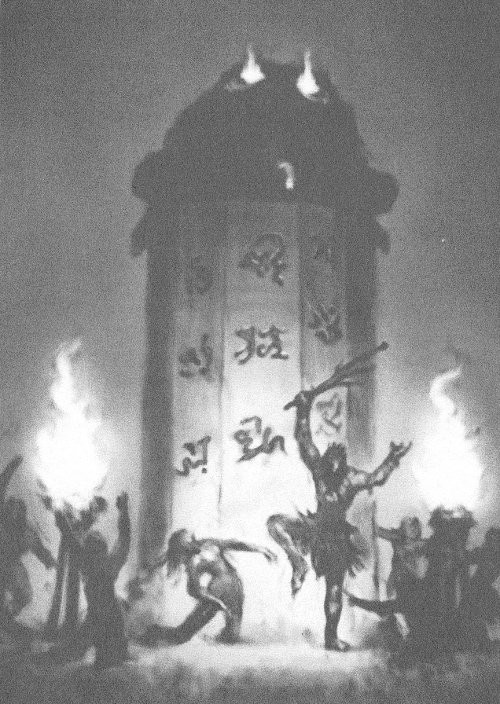
Source of image: http://f.hatena.ne.jp/servitors/20120603000419
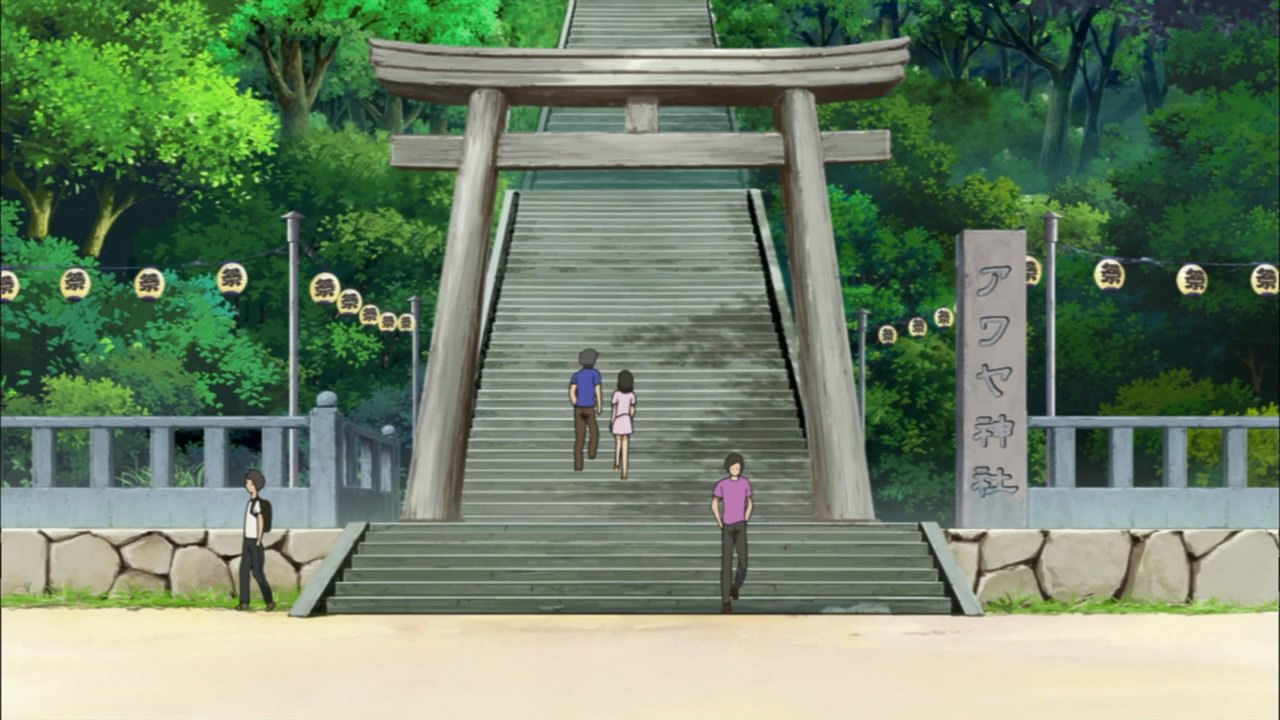
(18:20)
The sign reads "Awaya Jinja" (アワヤ神社), "Awaya Shrine". This is referencing "Megami Ibunroku Perusona" (女神異聞録ペルソナ), "Strange Tale of the Goddess Persona", a video game released by ATLUS (アトラス) in 1996.S3 In the game there is a location called "Araya Jinja" (アラヤ神社), "Araya Shrine". On a related note, Nyarlathotep appears in this game.

(18:43)
There are five references here:
* The pink bags at the top left have a picture that, like the box art in episode 1 at 7:36, is based on the cover art of volume 2 of "Makai Shoujo Ruruie Ruru" (魔海少女ルルイエ・ルル), "Girl From the Demonic Sea Ruruie Ruru", a light novel series written by Hazawa Kouichi (羽沢向一) and published in 2010. Image for reference:
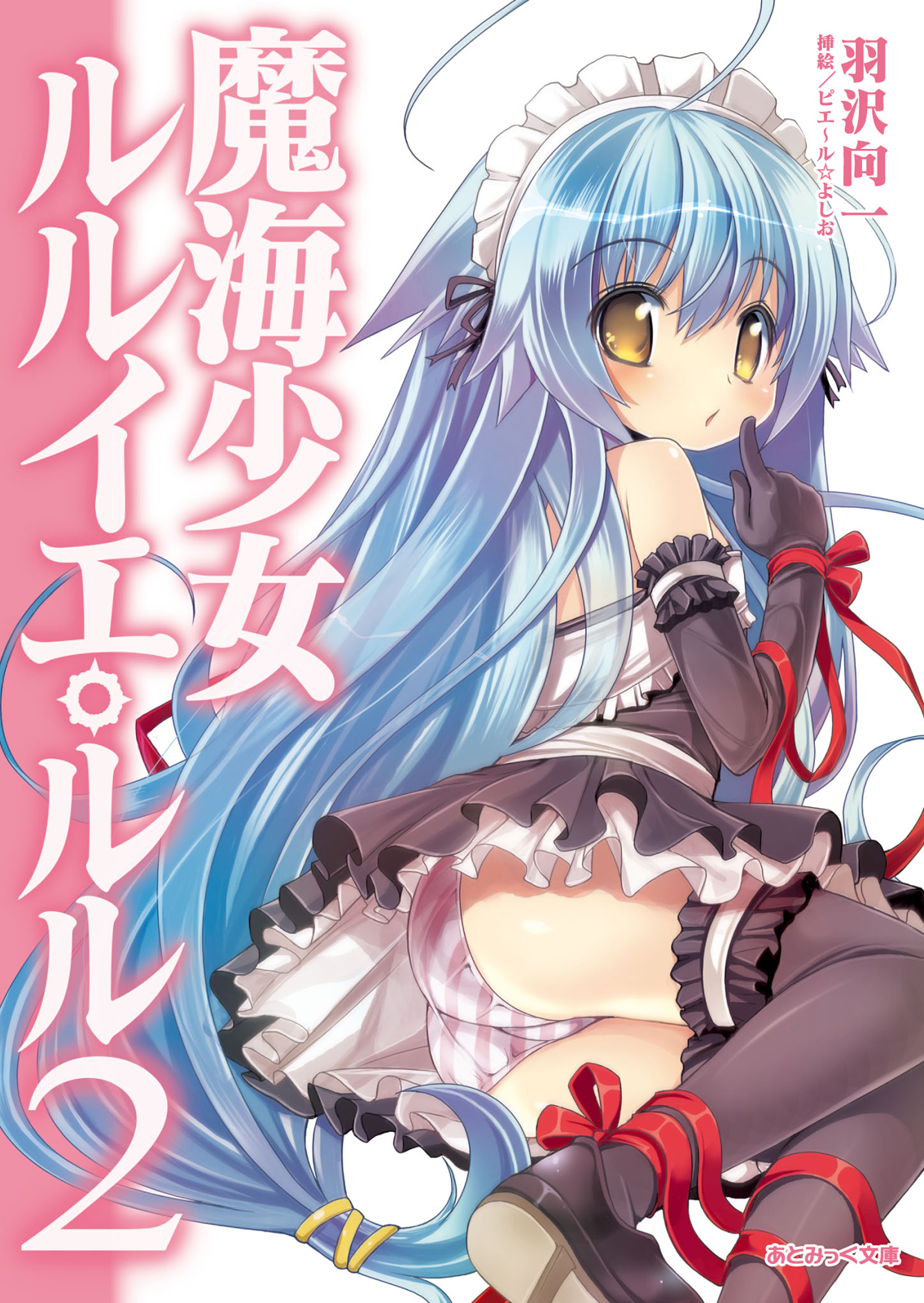
Source of image: https://bookwalker.jp/de7fbabf5d-dfc4-4c67-8169-e4dddfd058c5/
* The blue bags at the middle left have pictures of Iron Striver from "Hayore! Nyaruko-san" itself. He first appears in episode 1 at 3:15. Image for reference:
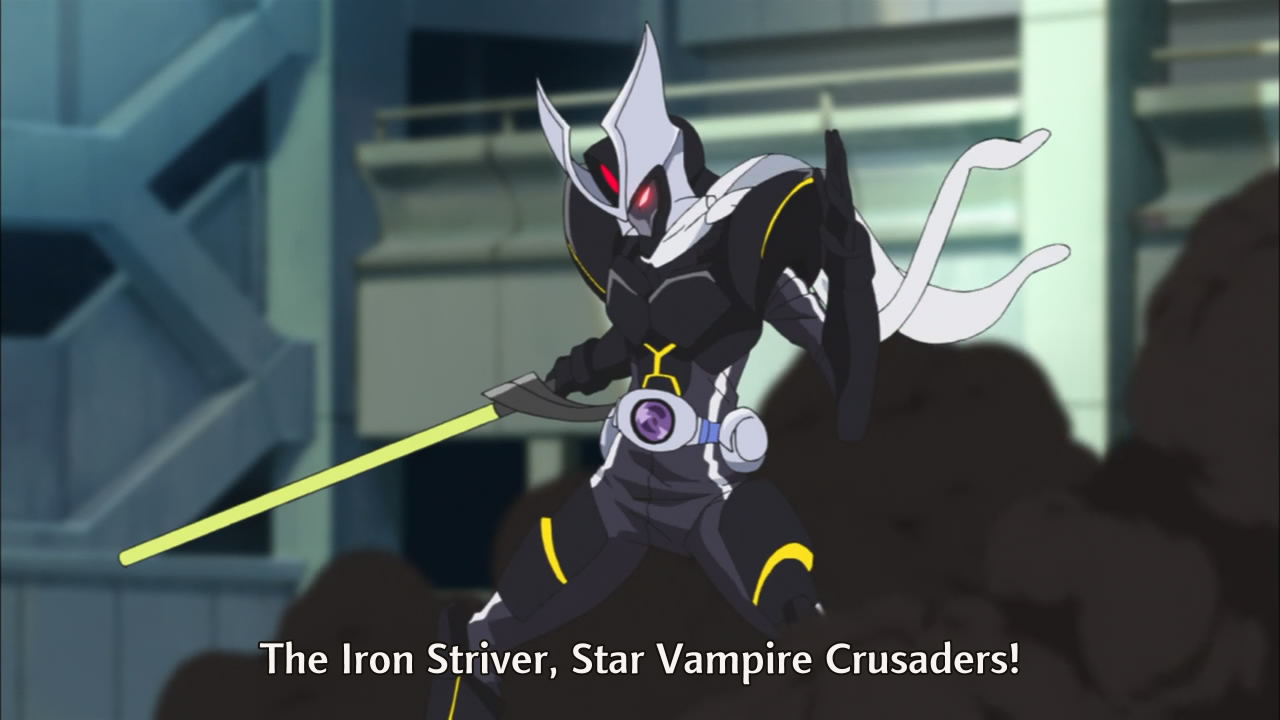
* The yellow bags to the left have a picture of girl who resembles Jashin-chan (邪神ちゃん) from "Yuri Seijin Naoko-san" (百合星人ナオコサン), "Yurian Naoko-san".S2 Image for reference:

Source of image: http://f.hatena.ne.jp/servitors/20120524185256
* The artwork on the yellow bags to the right is referencing the cover art for "Tatakae Houshi Shuzoku" (戦えっ奉仕種族), "Servantkind, Fight!", a "Call of Cthulhu" RPG replay book released by a doujinshi circle known as FGT in 1988.S4 Image for reference:
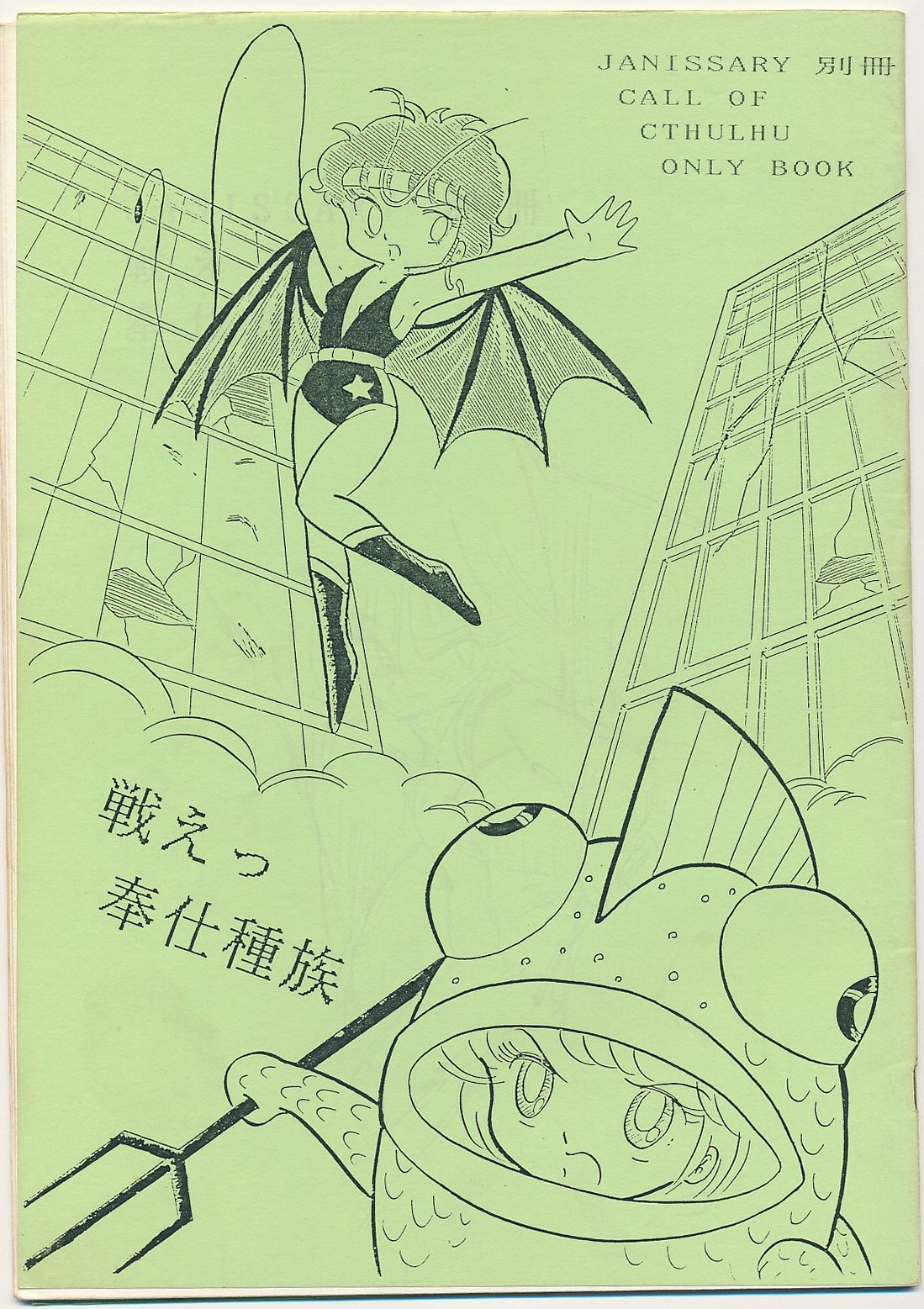
Source of image: http://moeponzu.com/blog-entry-1951.html
* The top character on the yellow bags to the right is referencing Kokujou Ruruie (黒条流瑠家), also known as Magical Girl Ruruie (魔法少女ルルイエ), from "Shinra Banshou Choko Zekusu Fakutaa" (神羅万象チョコ ゼクスファクター), "Universal Creation Chocolate Sixth Factor", a brand of chocolate wafers produced by Bandai (バンダイ) from 2010 to 2011.S4 Image for reference:
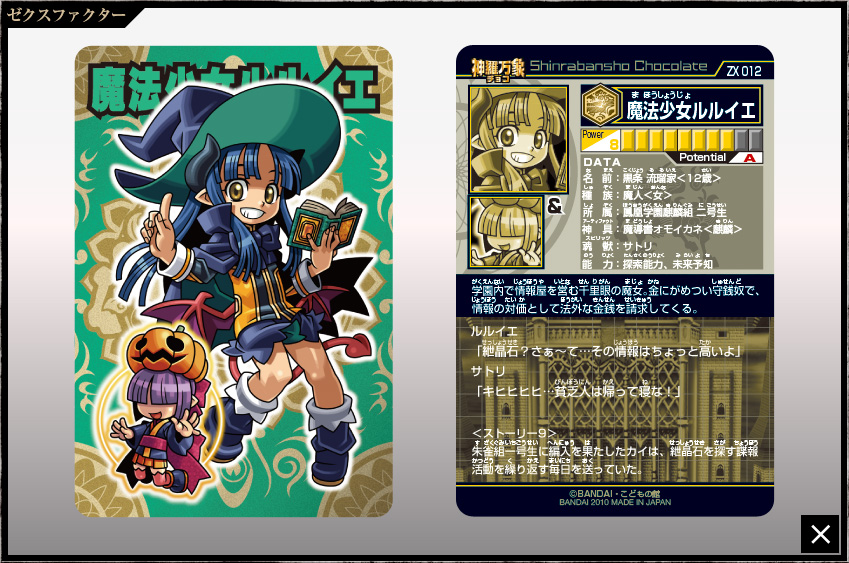
Source of image: https://shinrabansho.com/archive/zxf_charalist01.html
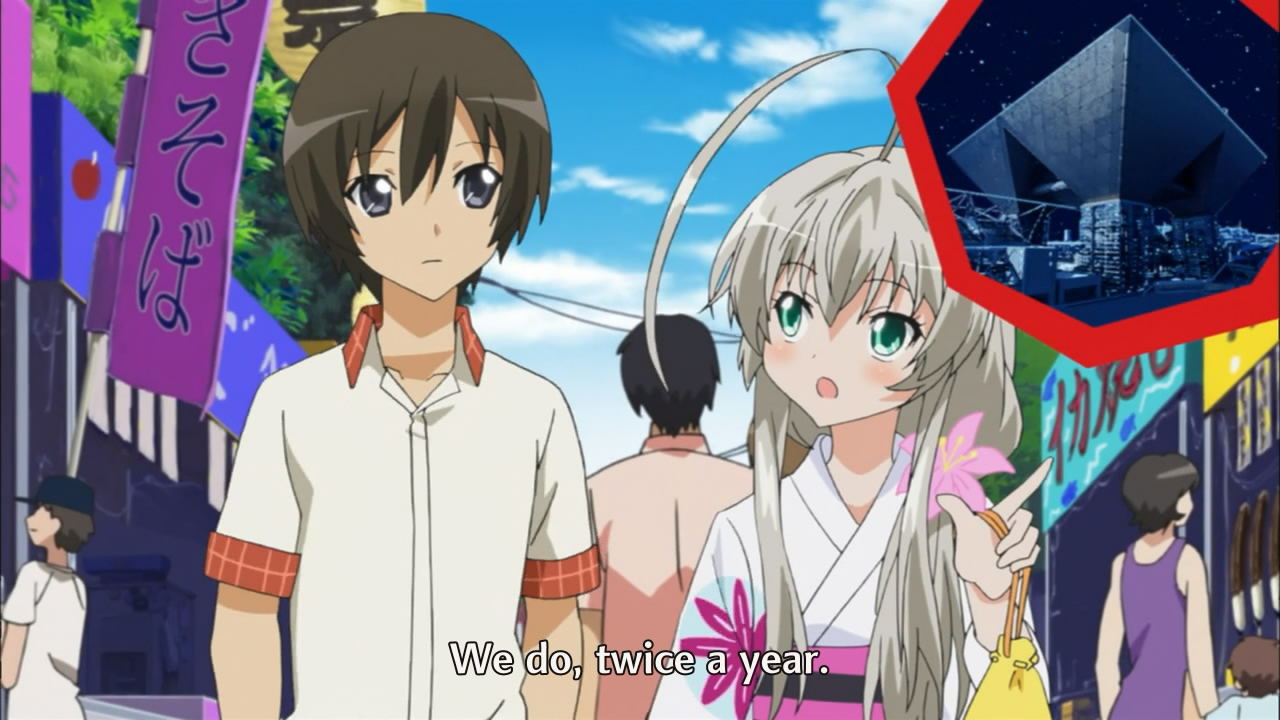
"We do, twice a year. In the summer and at New Year's at the Ariake Space colosseum." (18:52)
The festival that Nyaruko mentions is referencing Comiket, a convention held twice a year in Japan. In the summer it is held in August. In the winter it is held at the end of December, typically near New Year's. The convention is held at the Tokyo International Exhibition Center, nicknamed Tokyo Big Sight. The convention center pictured next to Nyaruko is also based on Tokyo Big Sight. Image for reference:

Source of image: https://en.wikipedia.org/wiki/File:20030727_27_July_2003_Tokyo_International_Exhibition_Center_Big_Sight_Odaiba_Tokyo_Japan.jpg
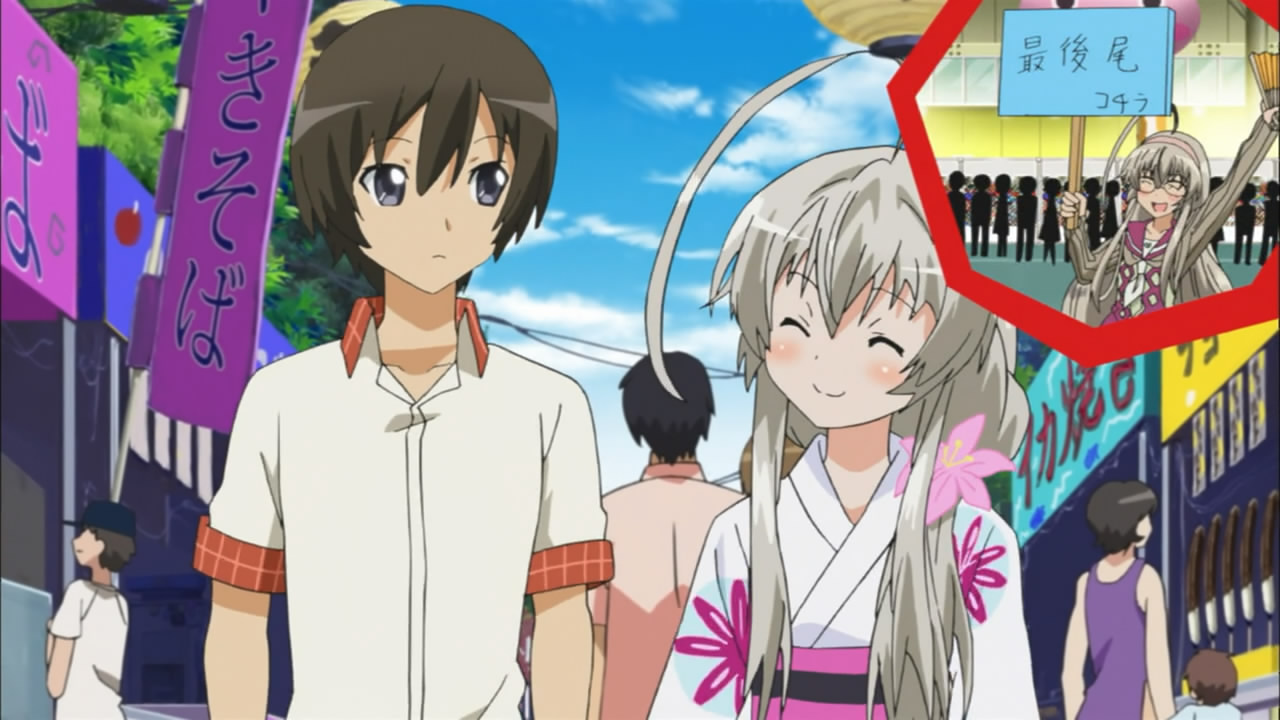
(18:56)
Nyaruko's costume is referencing Amagi Yukiko (天城雪子) from "Persona 4" (ペルソナ4), a video game released by ATLUS (アトラス) in 2008. The hairband, glasses, and diamond patterned shirt that Nyaruko is wearing are based on the clothes that Yukiko wears. Nyaruko is also holding a fan, which is referencing how Yukiko uses a fan as a weapon in the game.S1 Image for reference:
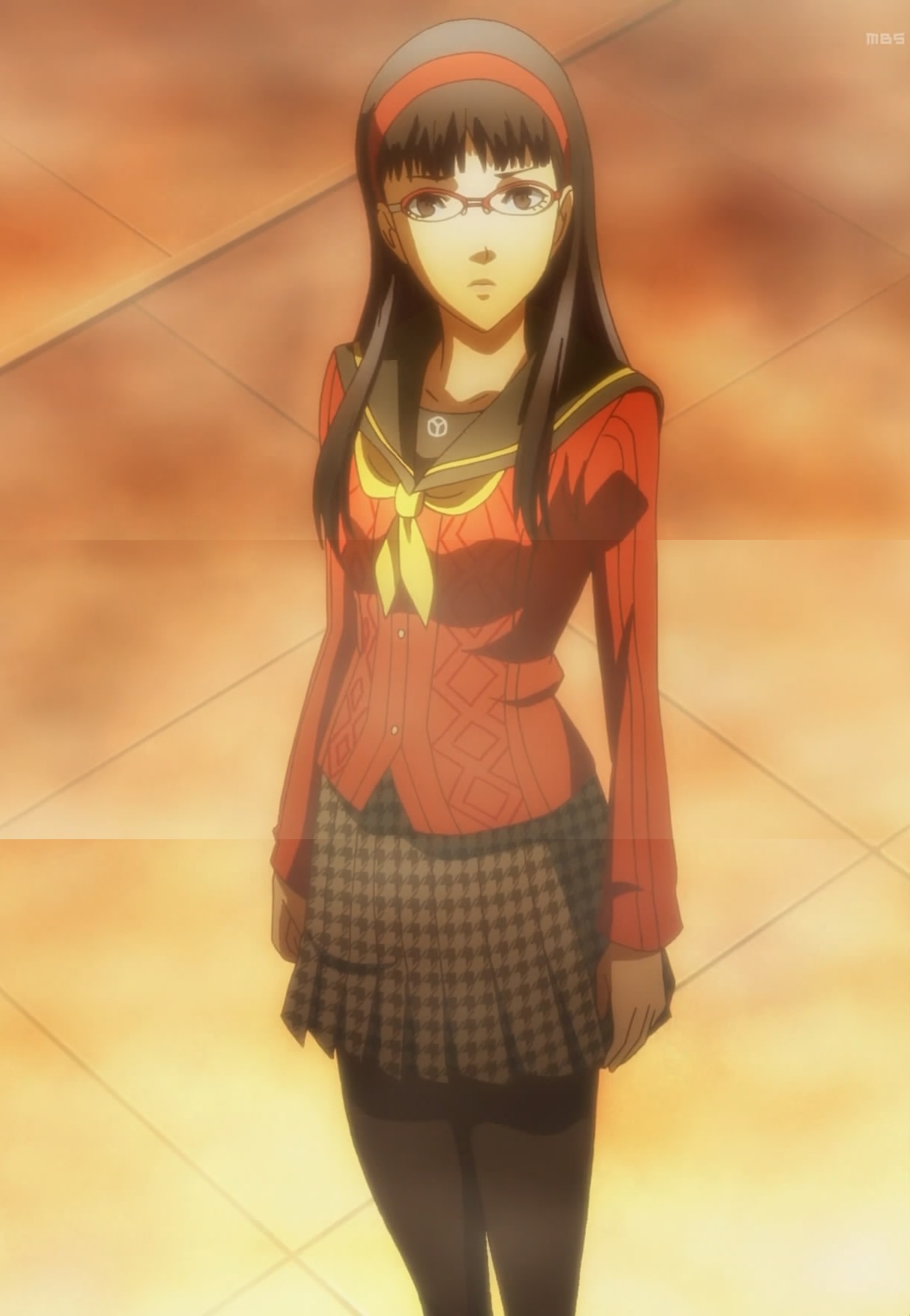
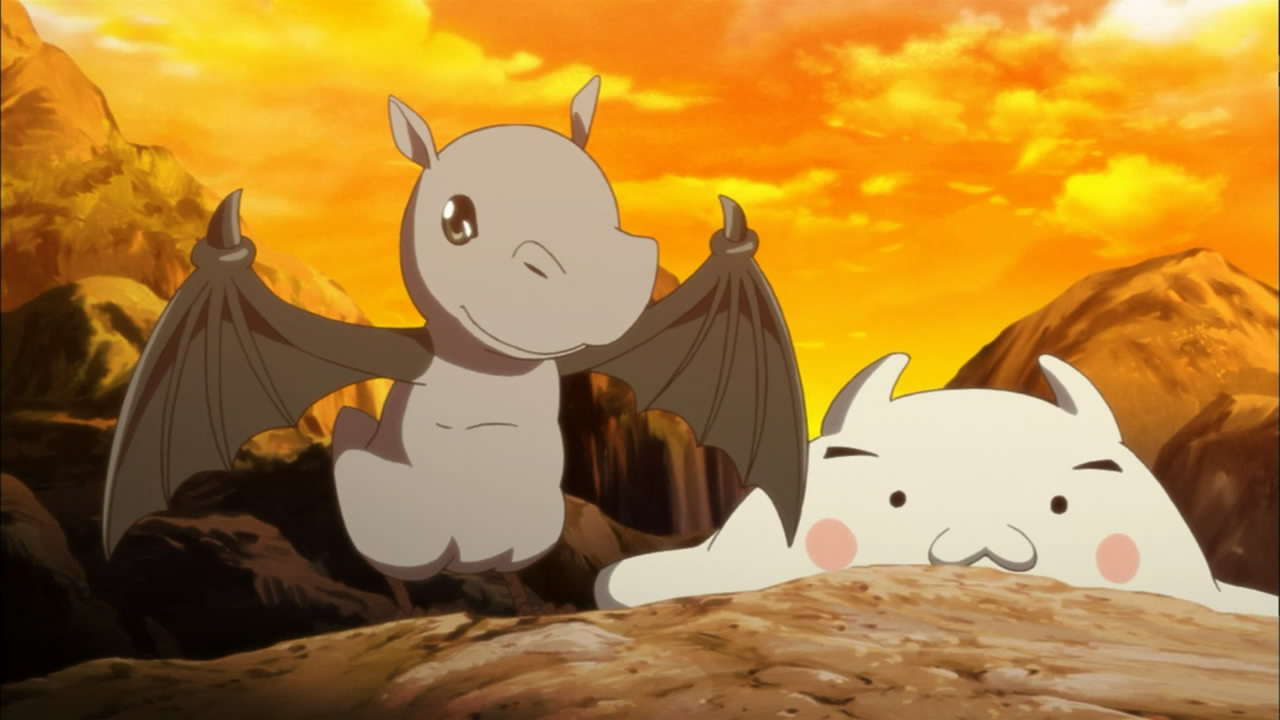
~< `・ω・´> (19:18)
Aisora sighting #4.
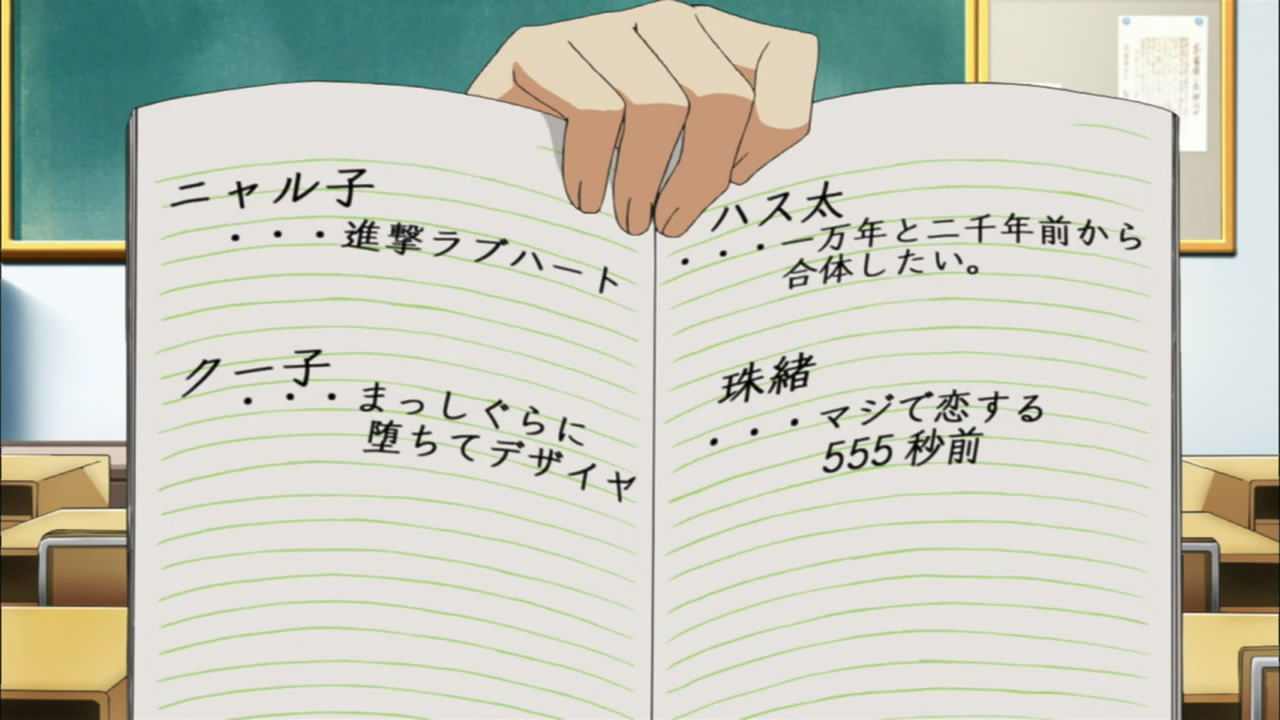
(23:46)
Each of the descriptions written is referencing a song. For details, please check the episode 8 post at 5:45.
"The next episode is 'Nyaruko's Exciting High School Life.'" (23:46)
The Japanese title is "Nyaruko no doki doki hai sukuuru" (ニャル子のドキドキハイスクール). This is referencing "Nakayama Miho no Tokimeki Hai Sukuuru" (中山美穂のトキメキハイスクール), "Nakayama Miho's Heatbeat High School", a game released by Nintendo (任天堂) and Square (スクウェア) in 1987.S1
(23:49)
The lines at this time go as follows:
「思い出すわ、学生の頃の気持ち」These lines are referencing a commercial that first aired in March of 2012 for SoftBank (ソフトバンク), a Japanese telecommunications and Internet corporation. On a related note, the "Haiyore! Nyaruko-san" light novel series is published by SOFTBANK Creative, a subsidiary of SoftBank.S1 The original lines in the commercial go as follows:
「おかしい事はおかしいって言う勇気」
「お母さんのスカートが短くて、おかしいと思う」
"Omoidasu wa, gakusei no koro no kimochi"
"Okashii koto ha okashii tte iu yuuki"
"Okaa-san no sukaato ga mijikakute, okashii to omou"
"Ah I can remember it, the feelings from when I was a student."
"The courage to say that strange things are strange."
"Mom, I think it's strange how short your skirt is."
「ねぇ、ちょっと無理やるんじゃない?」Video for reference: https://youtu.be/uAwxpA_oSqI?t=1611
「お似合いです!」
「あ、そうかしら?」
「短すぎるぞお前!」
「でもなんでこの格好?」
「取り戻してほしいから」
「何を?」
「学生の頃の気持ちを」
「でも、スカートは短い」
「おかしい事を、おかしいって言う勇気」
「おかしい?」
「スカートは短くておかしい!」
「いつの間にか規約になった人と人との絆とか」
「お母さんのスカートが短すぎるとか」
「学割は家族も三年無料だとか」
「それはおかしくないでしょう」
「繰り返すようですが、スカートは」
「学生も家族も三年間タダ。ソフトバンク」
"Nee, chotto muri yaru n ja nai?"
"Oniai desu!"
"A, sou kashira?"
"Mijika sugiru zo omae!"
"Demo nande kono kakkou?"
"Torimodoshite hoshii kara"
"Nani wo?"
"Gakusei no koro no kimochi wo"
"Demo, sukaato ha mijikai"
"Okashii koto wo, okashii tte iu yuuki"
"Okashii?"
"Sukaato ha mijikakute okashii!"
"Itsu no ma ni ka kiyaku ni natta hito to hito no kizuna toka"
"Okaa-san no sukaato ga mijikasugiru toka"
"Gakuwari ha kazoku mo san nen muryou da toka"
"Sore ha okashiku nai deshou"
"Kurikaesu you desu ga, sukaato ha"
"Gakusei mo kazoku mo san nen kan tada. Sofutobanku"
"Hey am I overdoing it a bit?"
"It looks great on you!"
"Ah, really?"
"Hey that's too short!"
"But why these clothes?"
"Because I want to reclaim them."
"What?"
"The feelings from when I was a student."
"However the skirt is too short."
"The courage to say that strange things are strange."
"Strange?"
"It's strange how short your skirt is!"
"Things like bonds between people turning into agreements without realizing it."
"Or how mom's skirt is too short."
"Or student discounts including families for free for 3 years."
"That's not weird at all."
"I repeat, the skirt is—"
"Students and families are free for 3 years. Softbank."
List of sources:
S1. Comments on this post
S2. A post at Steman Blog (ステマブログ)
S3. Japanese Nyaruko References Wiki (這いよれ! ニャル子さん 元ネタwiki)
S4. A blog by servitors about Cthulhu Mythos inspired works (クトゥルー/クトゥルフ神話作品発掘記)
Thanks to everyone who contributed! This list wouldn't be nearly as long without you all. See you next episode!
情報を教えてくださって本当にありがとうございました!皆さんがいなかったら、このリストはぜんぜん長くありません。またこの次までね!
Last updated July 18, 2012
Sitemap
Home
